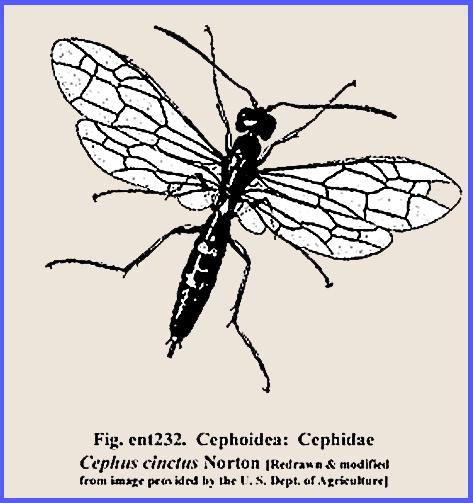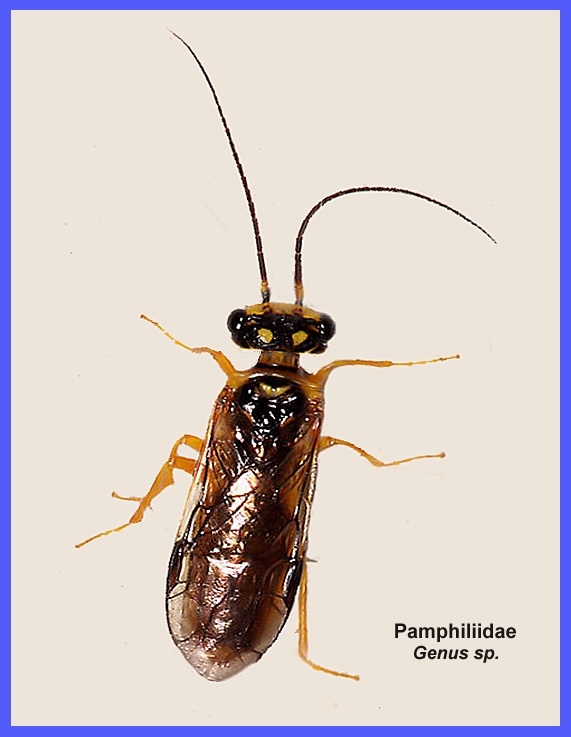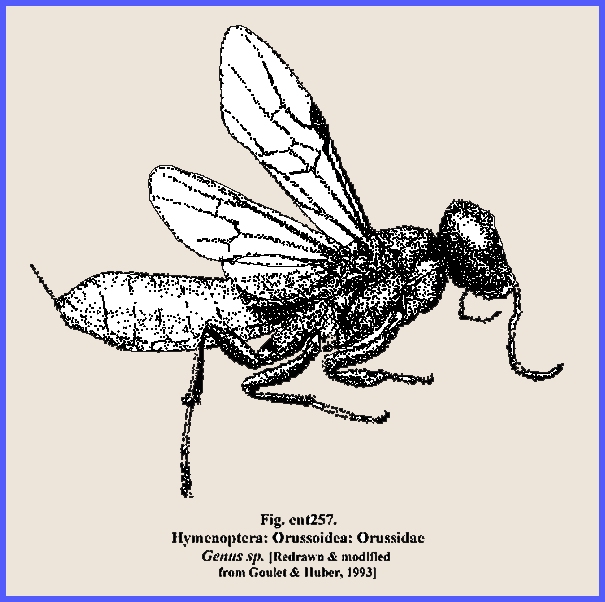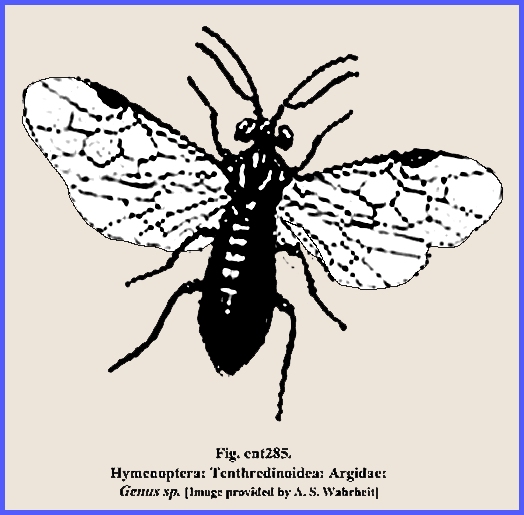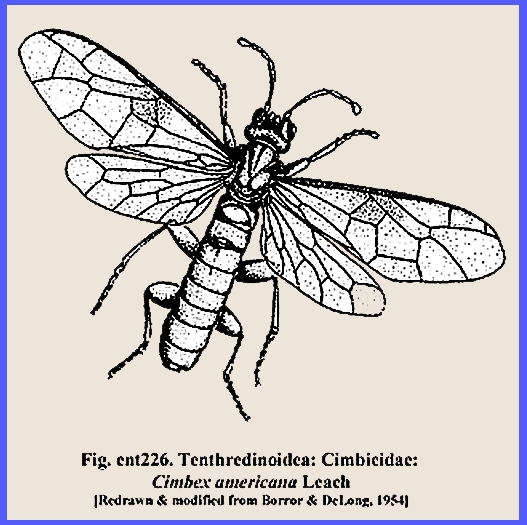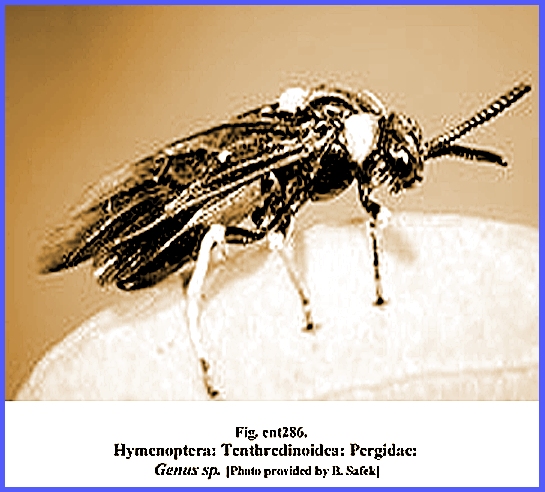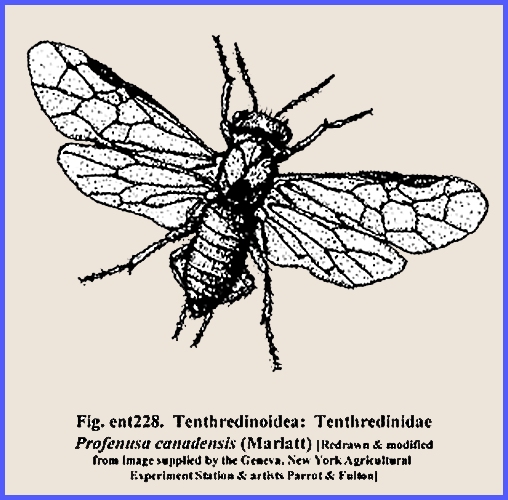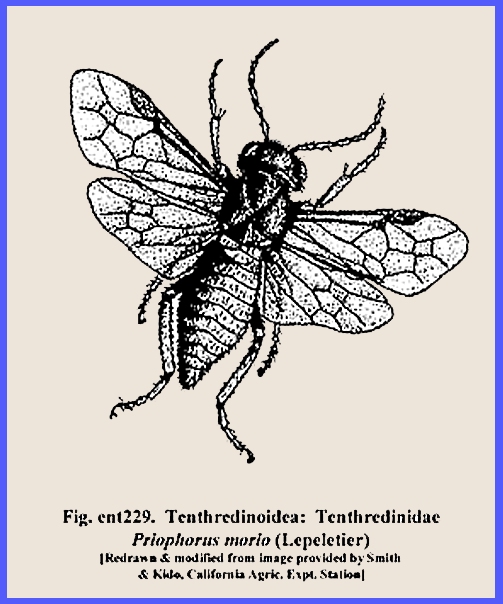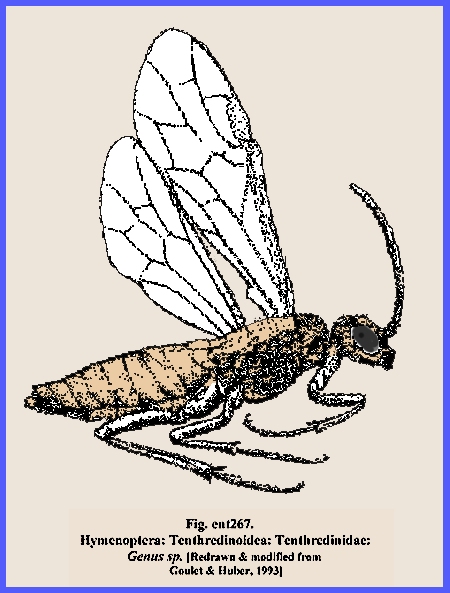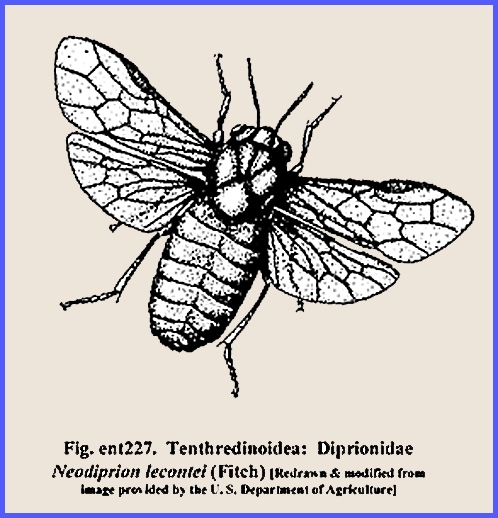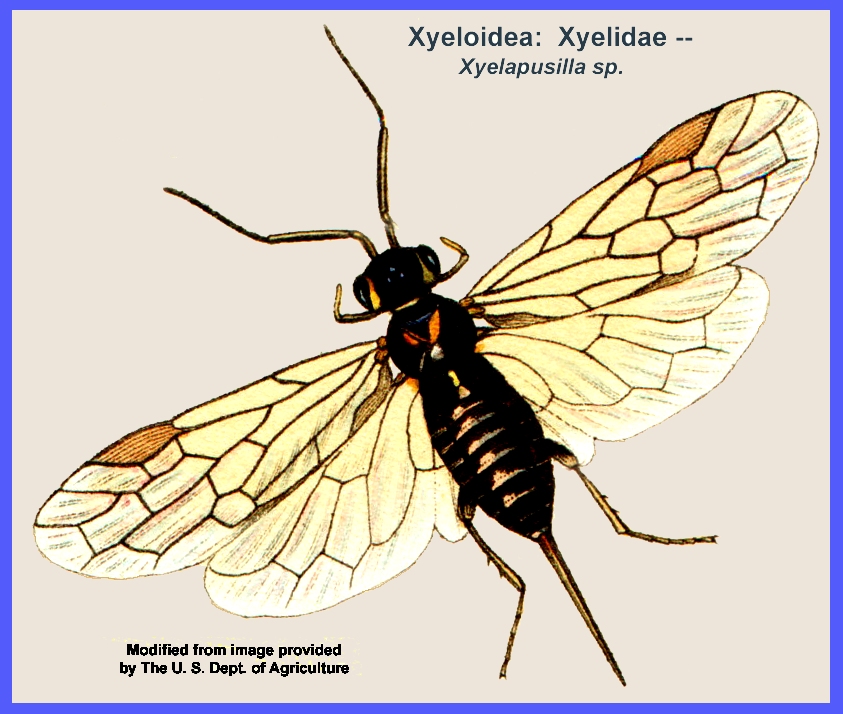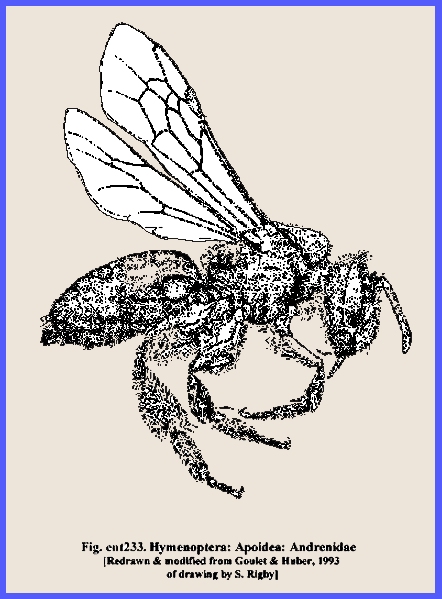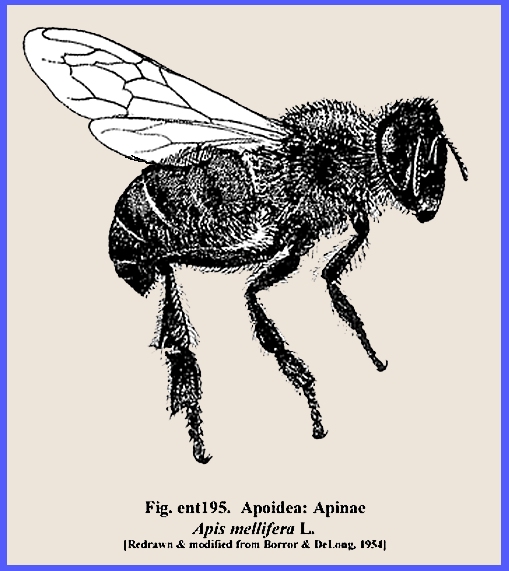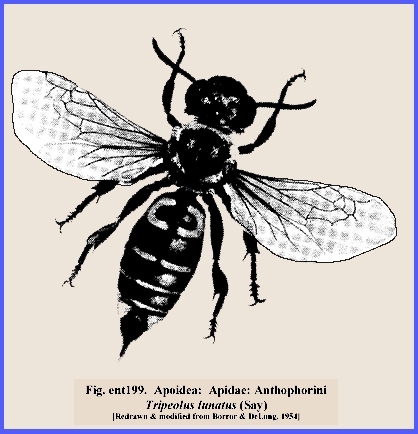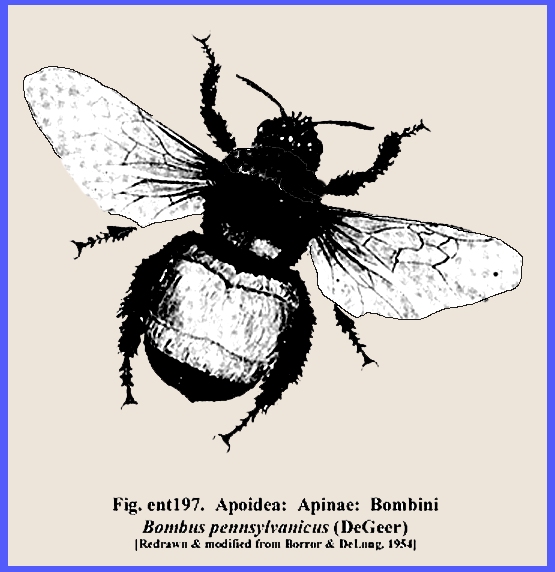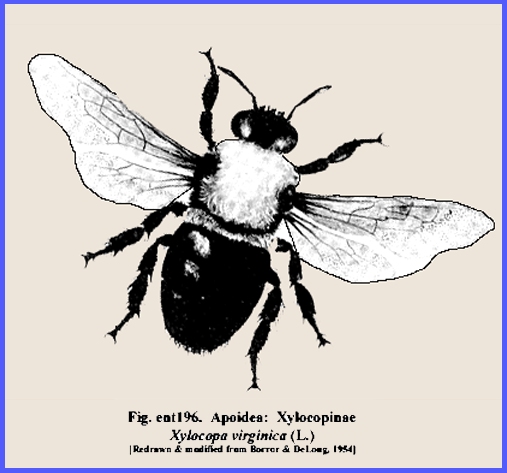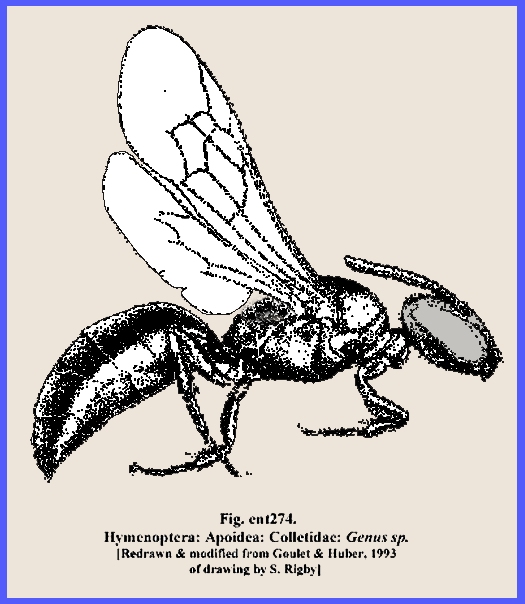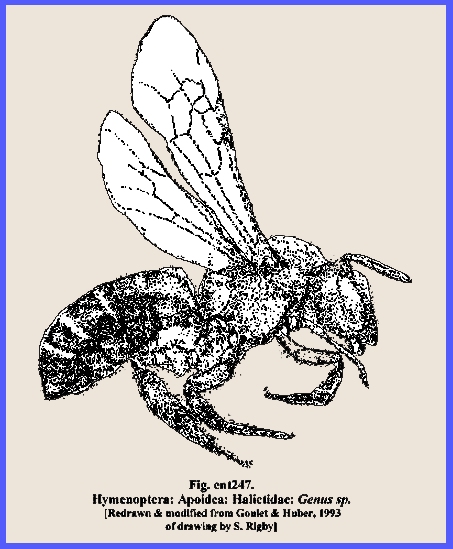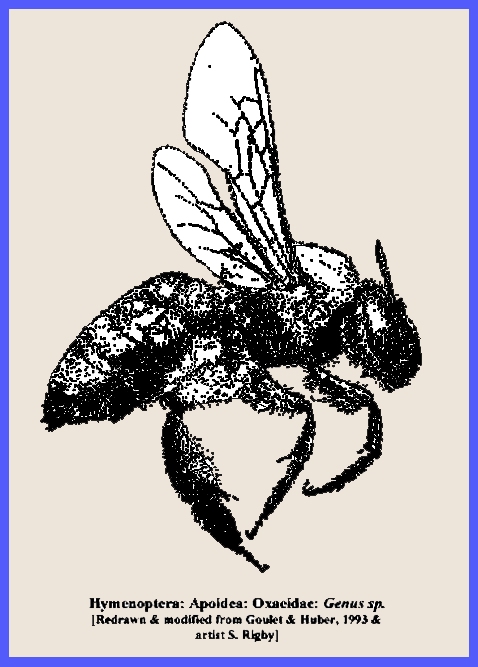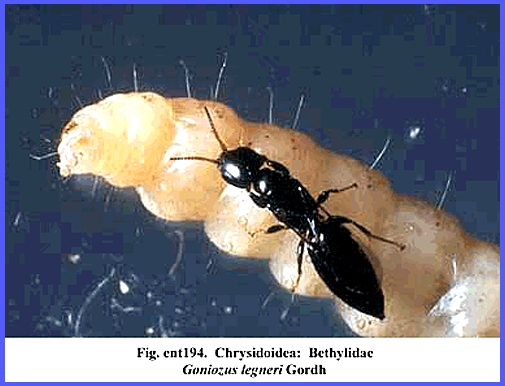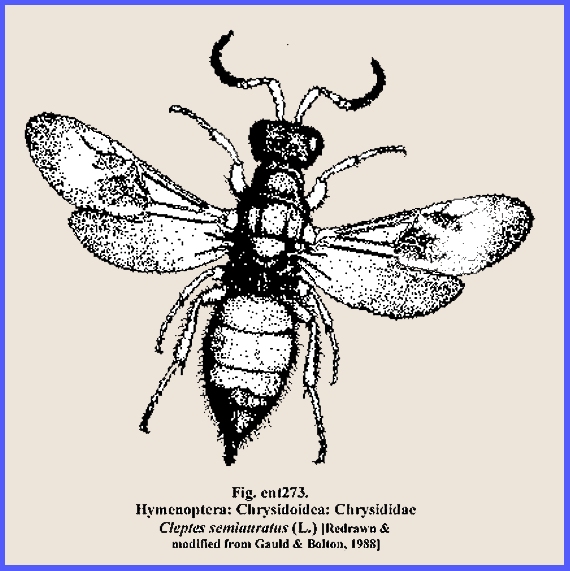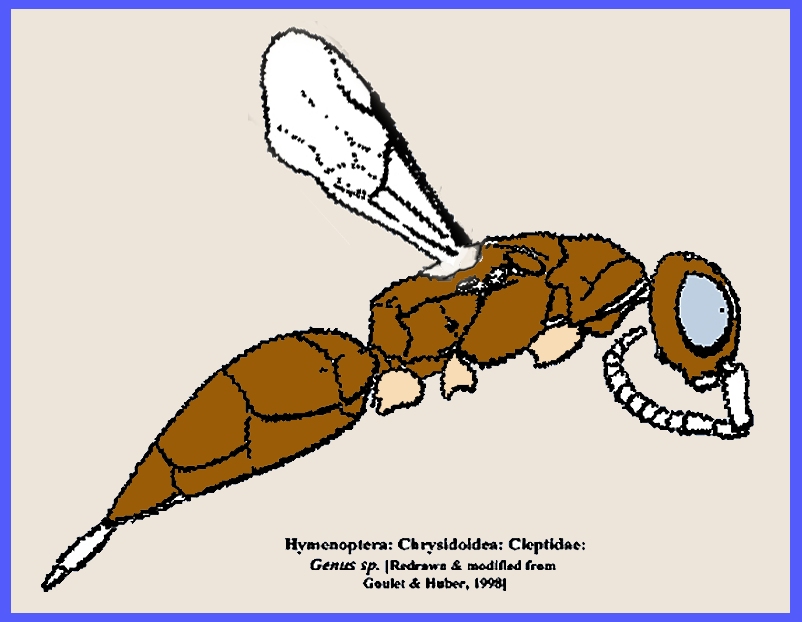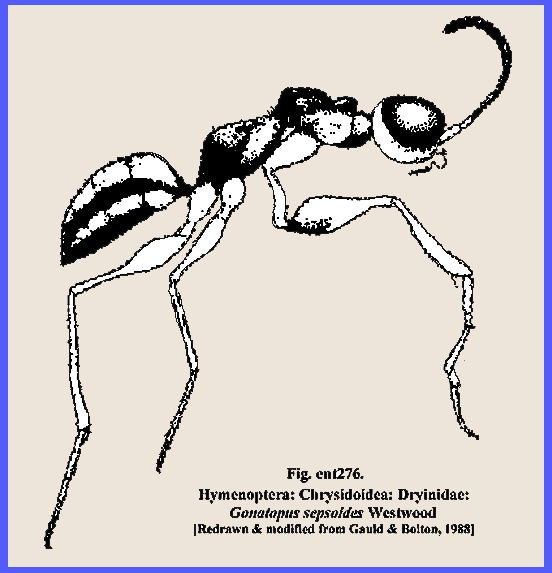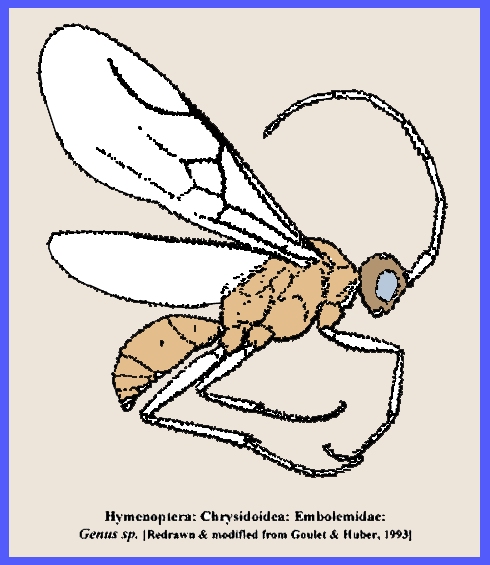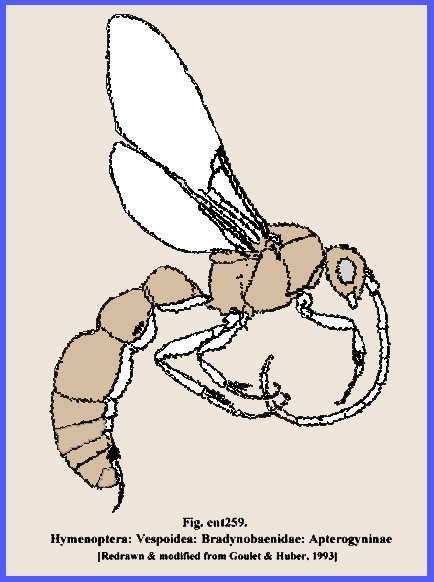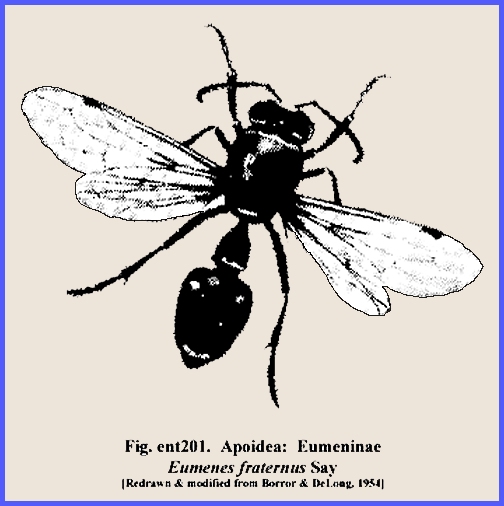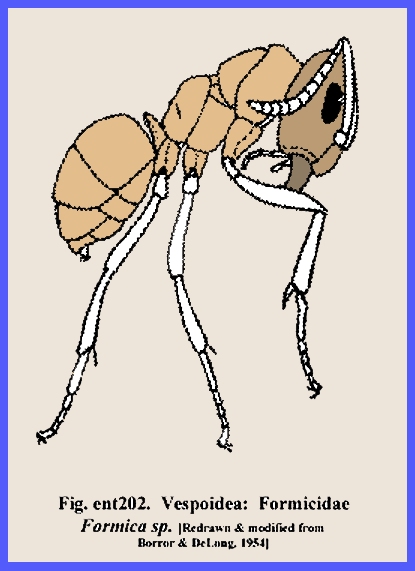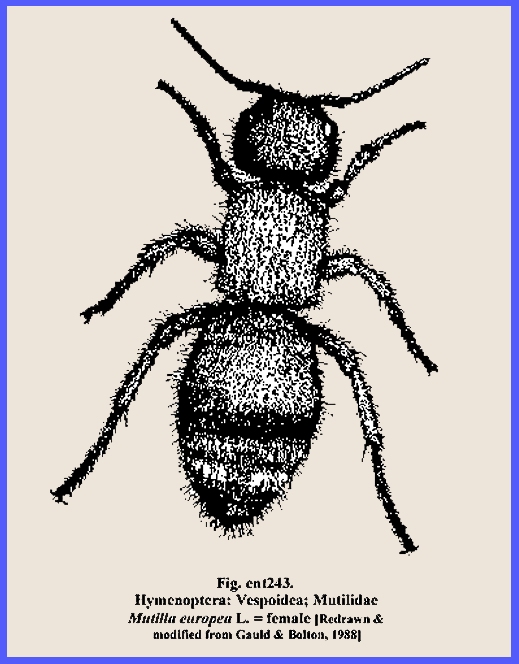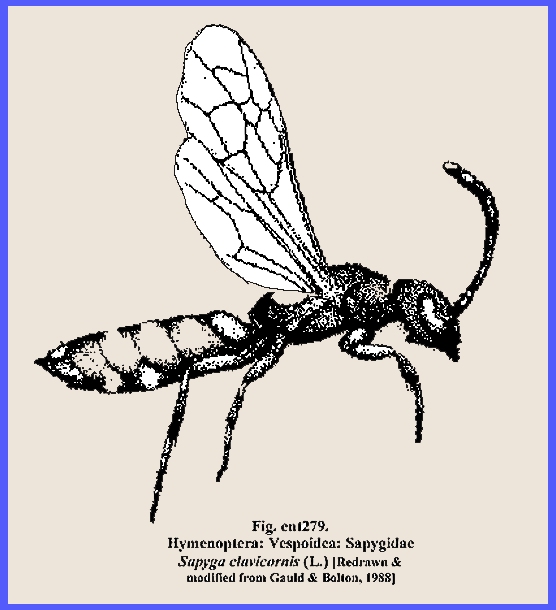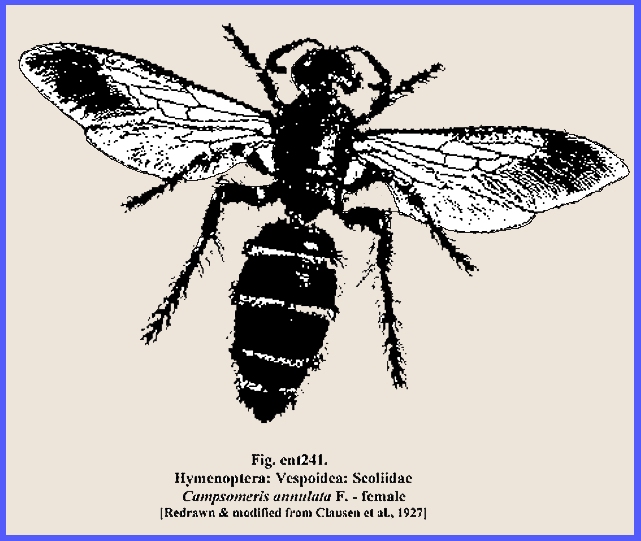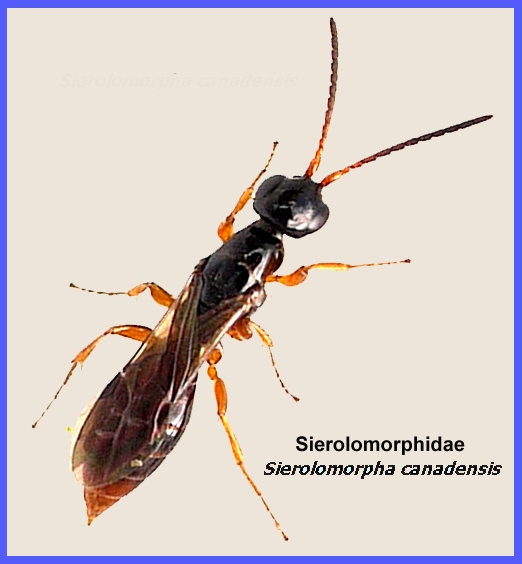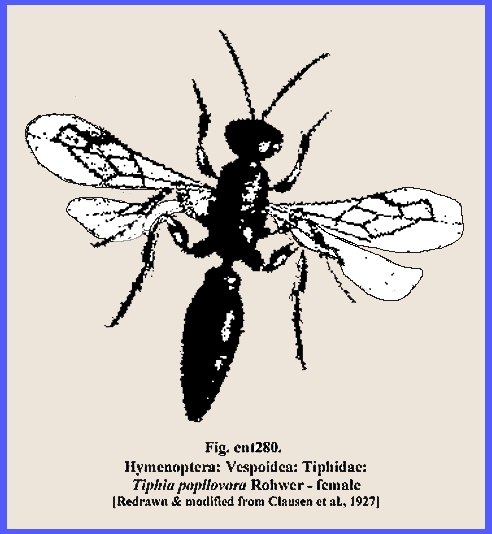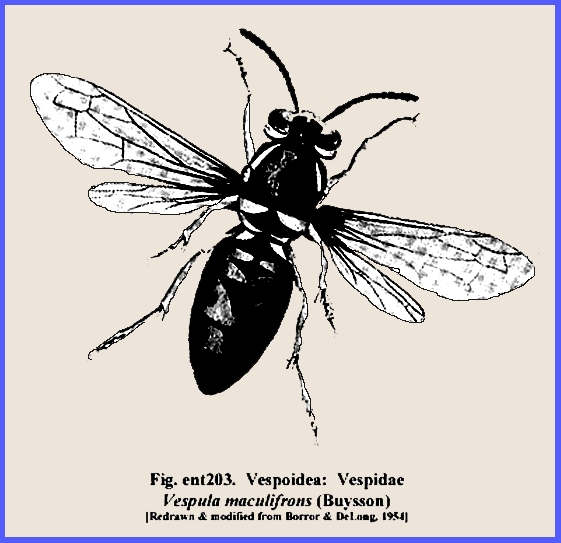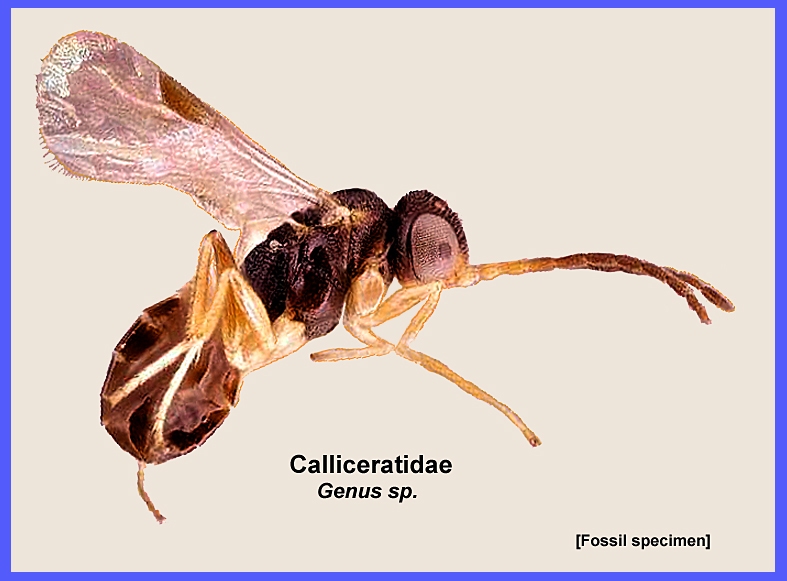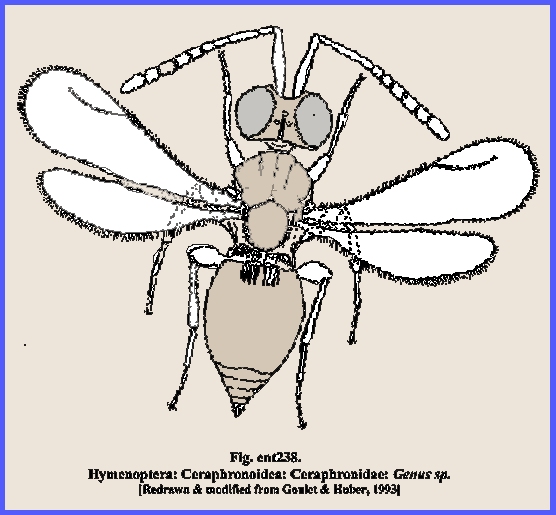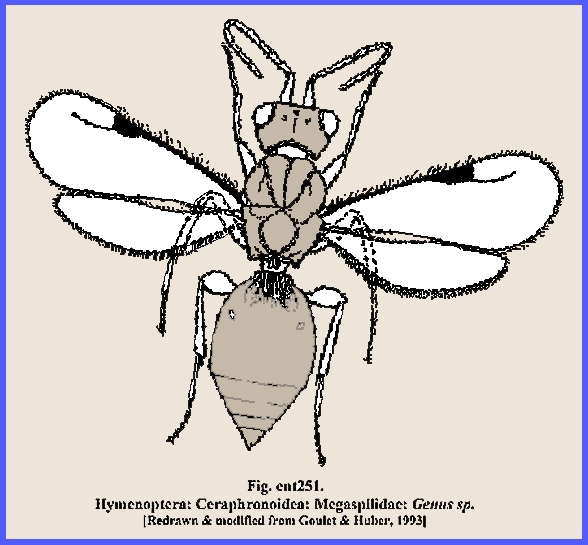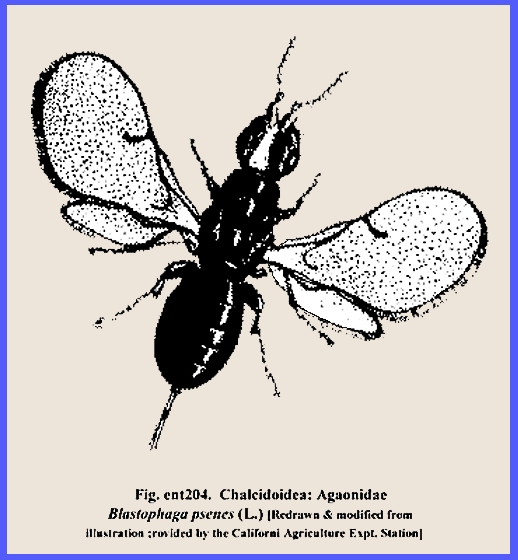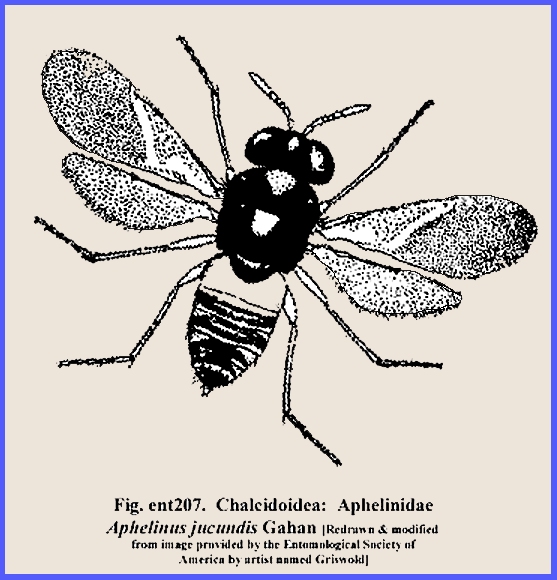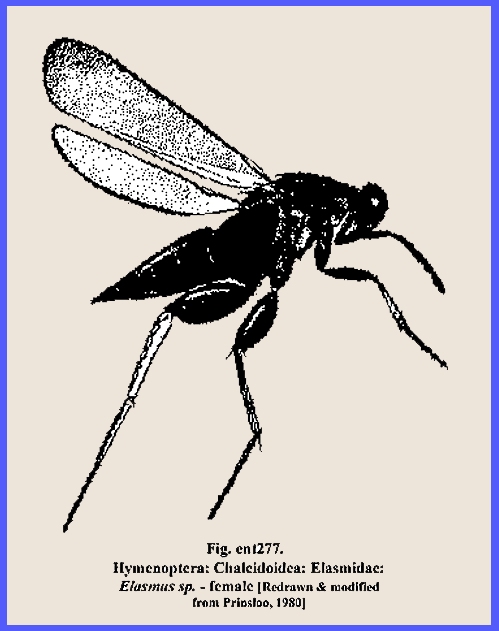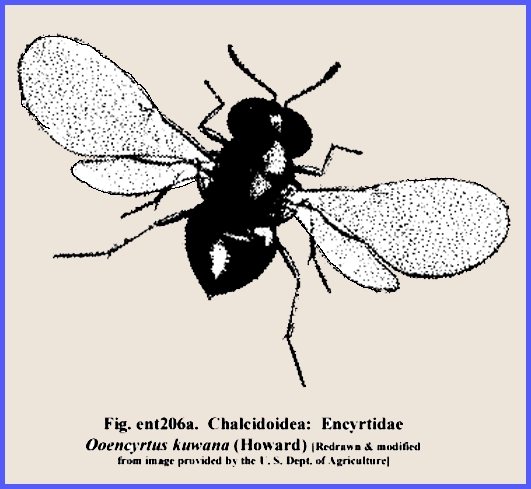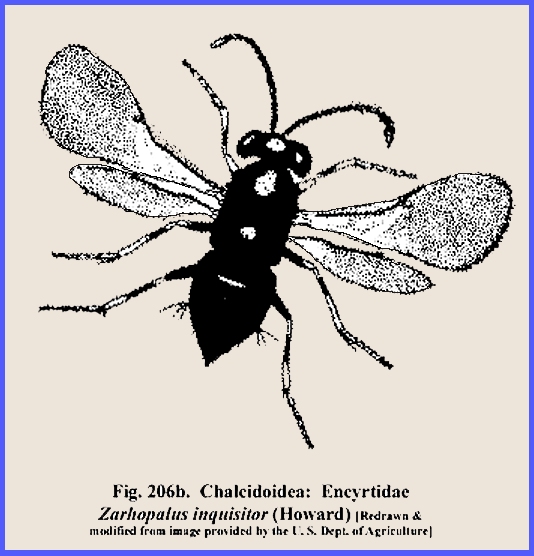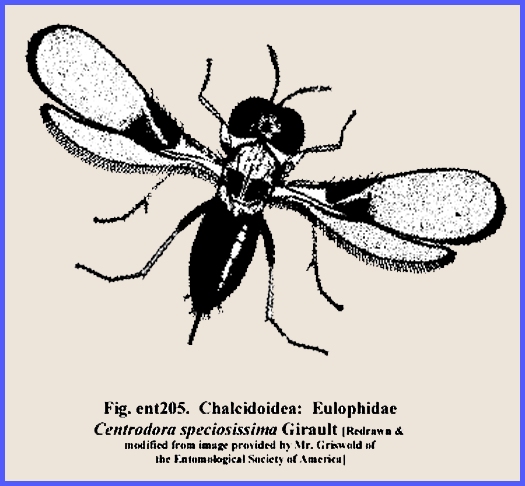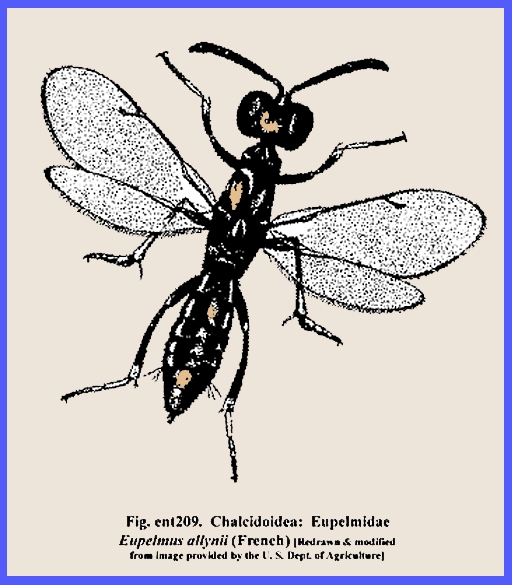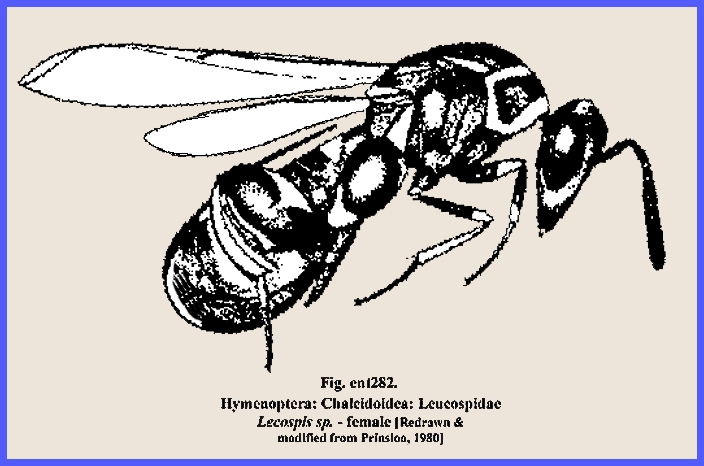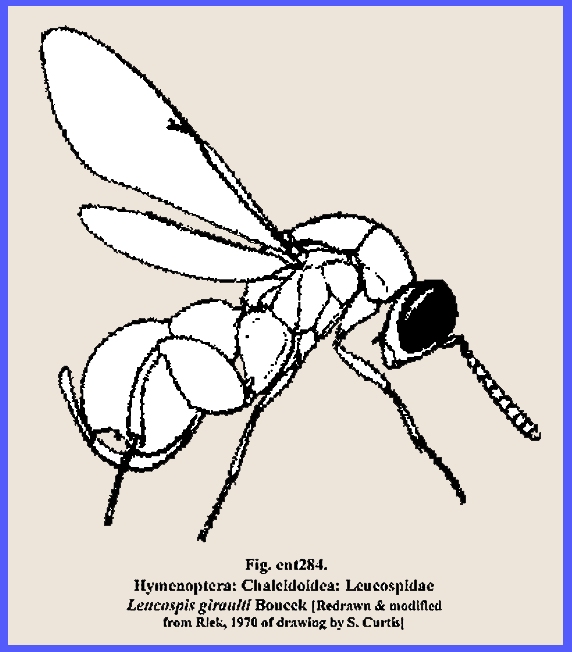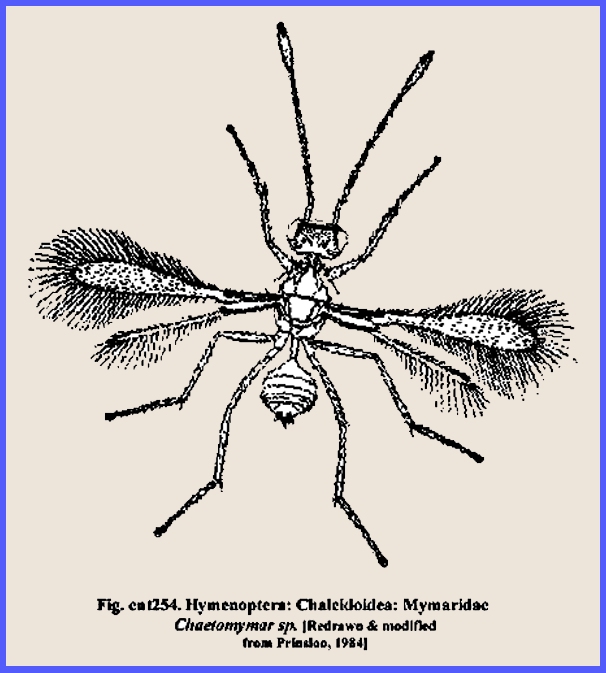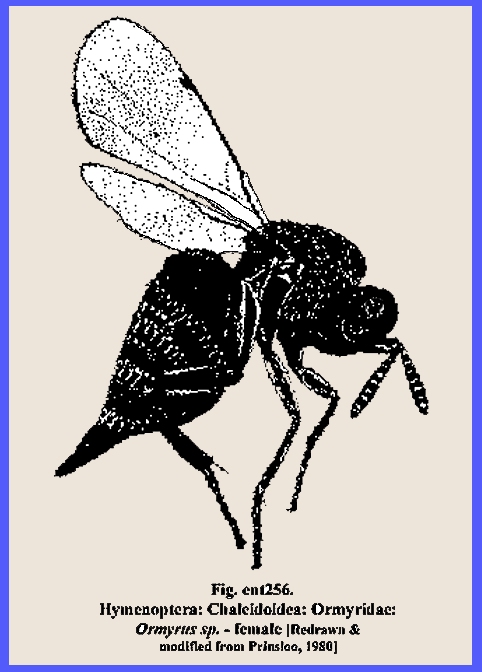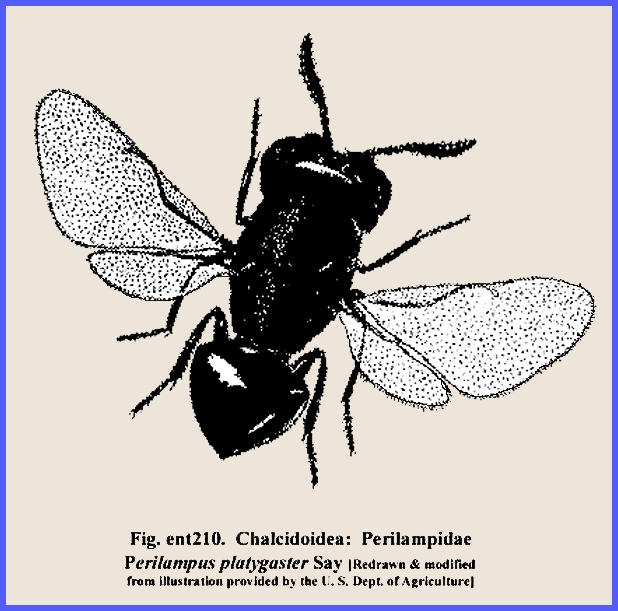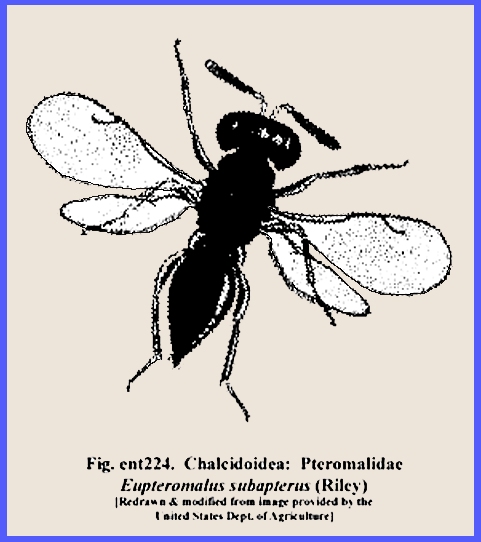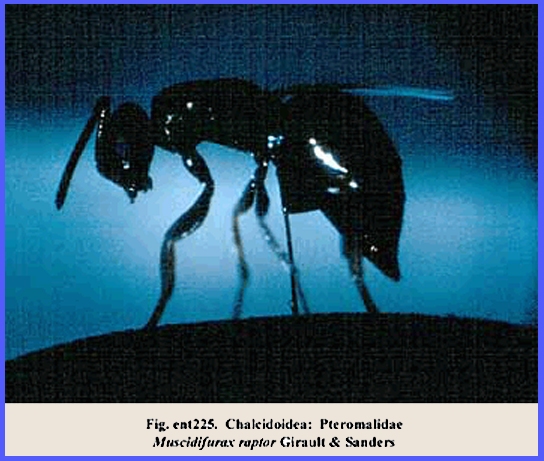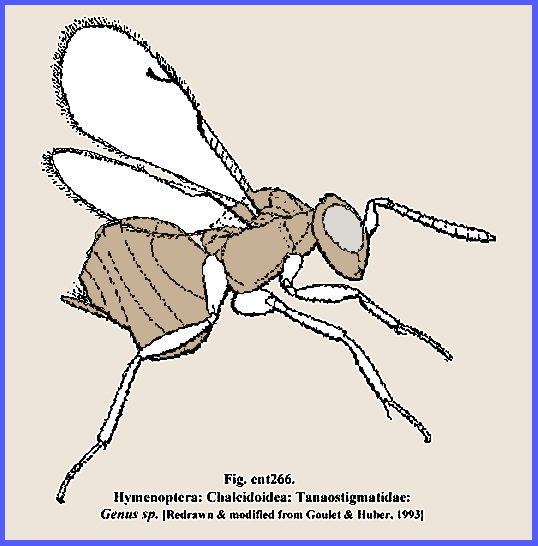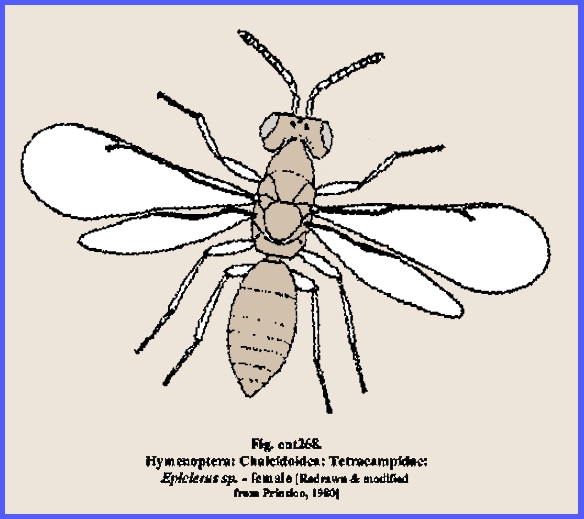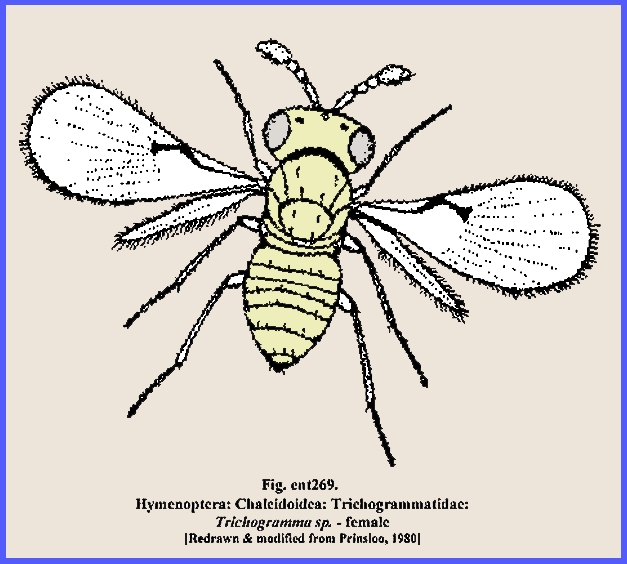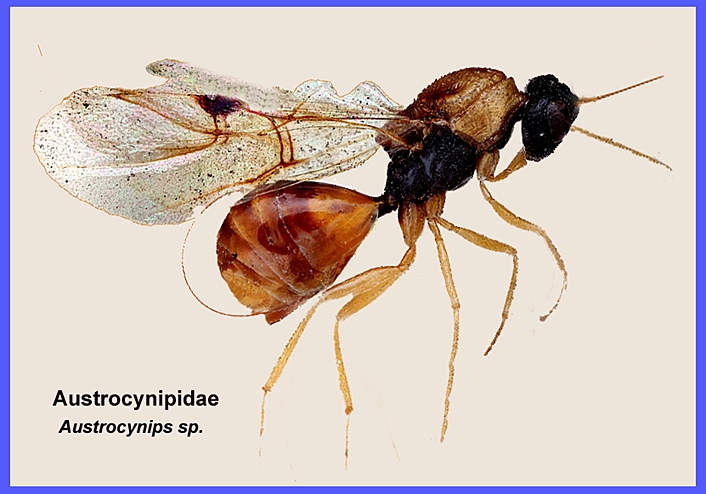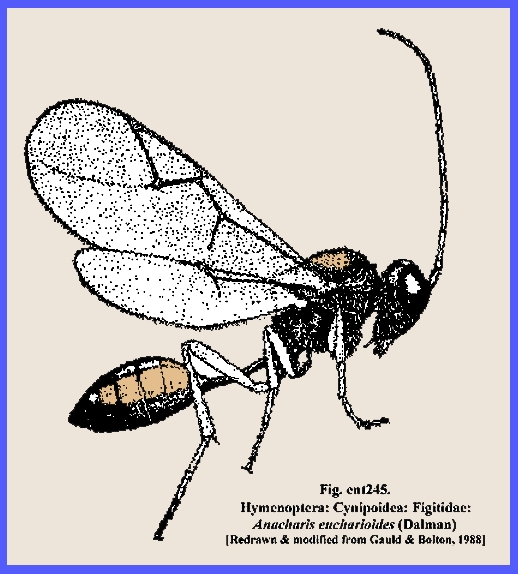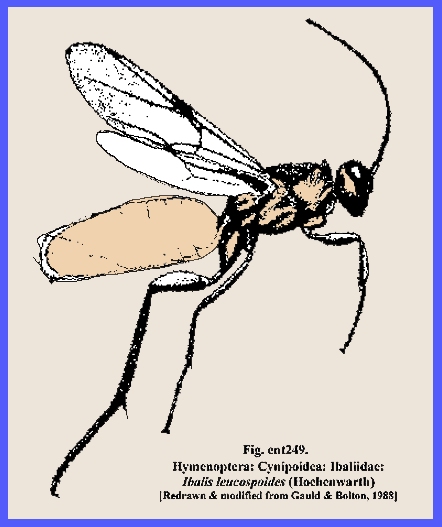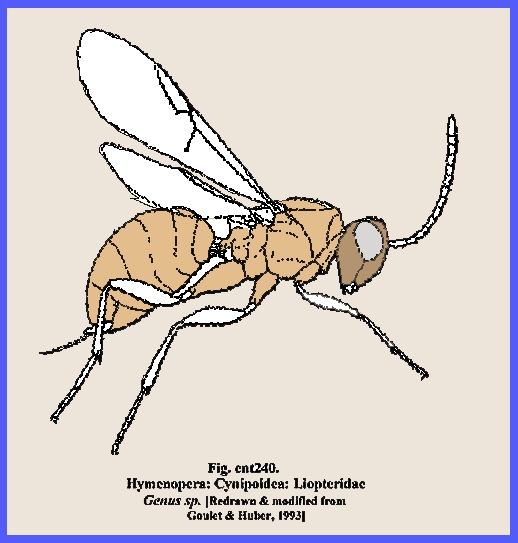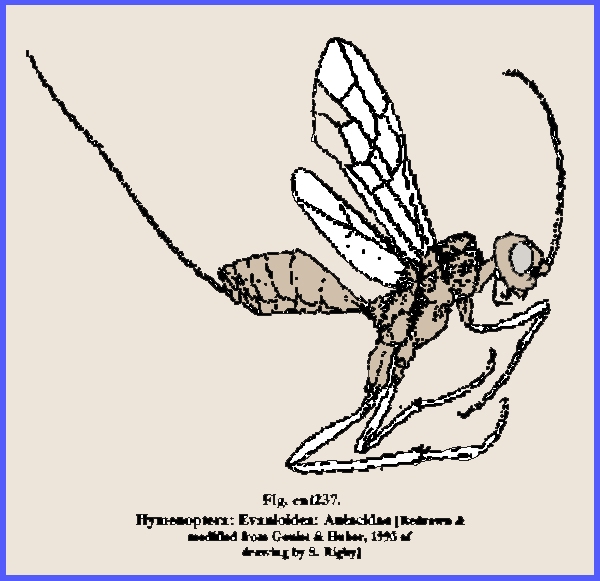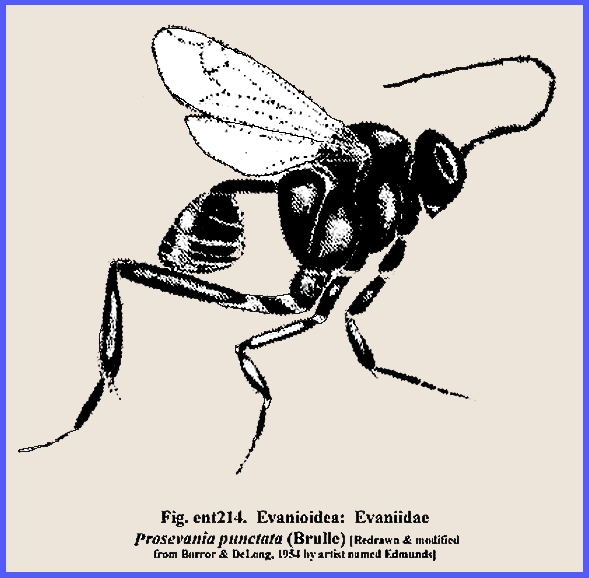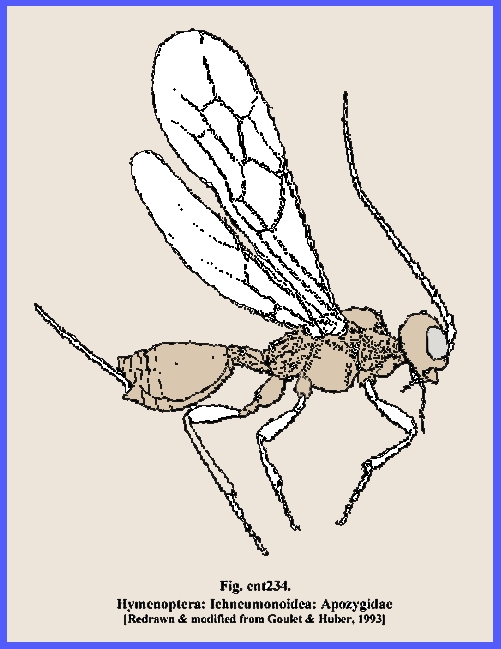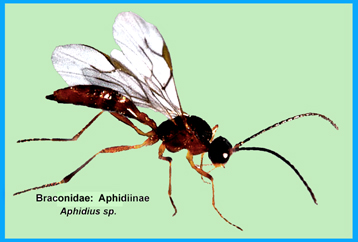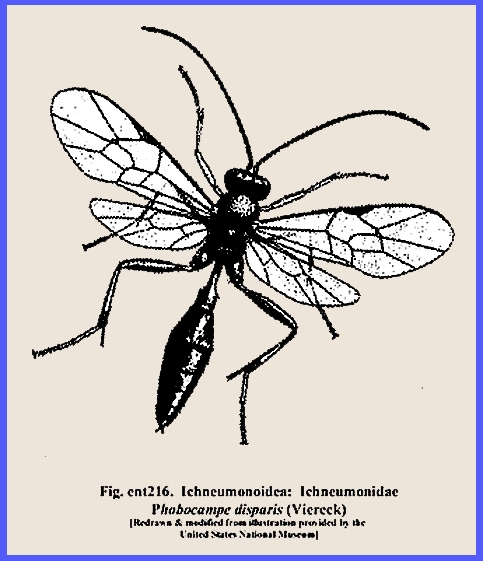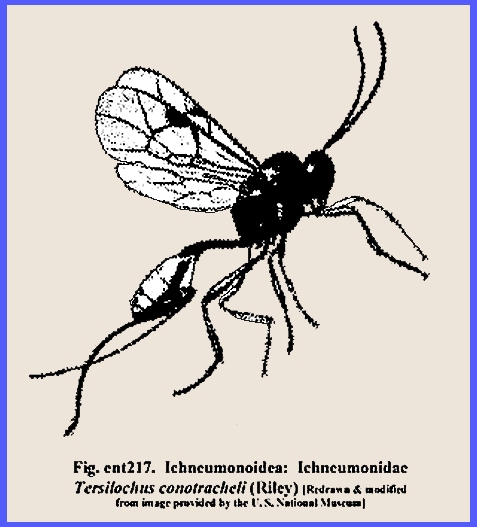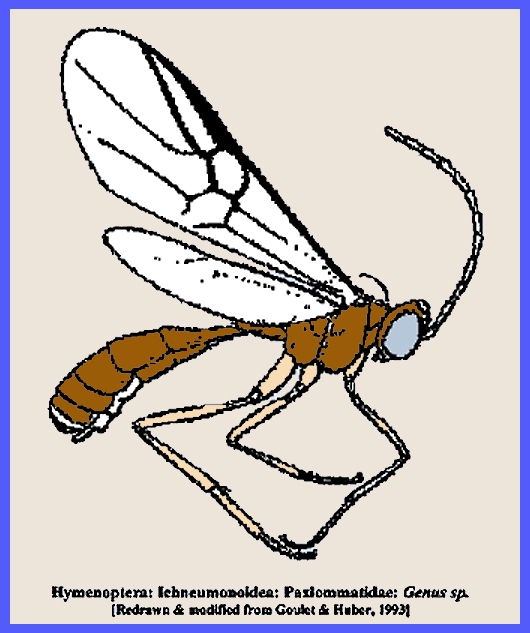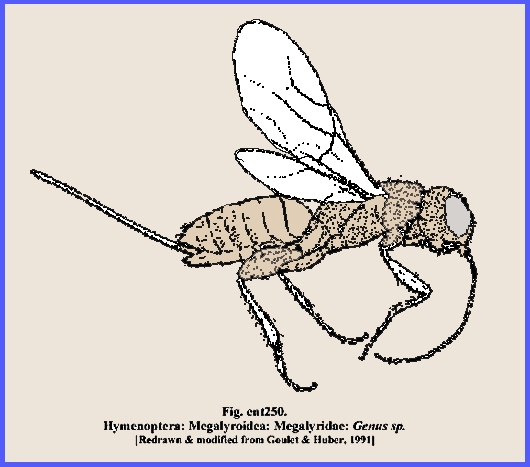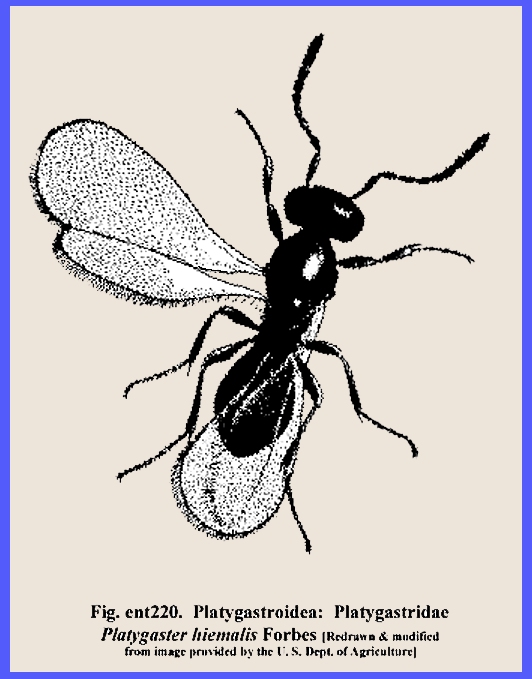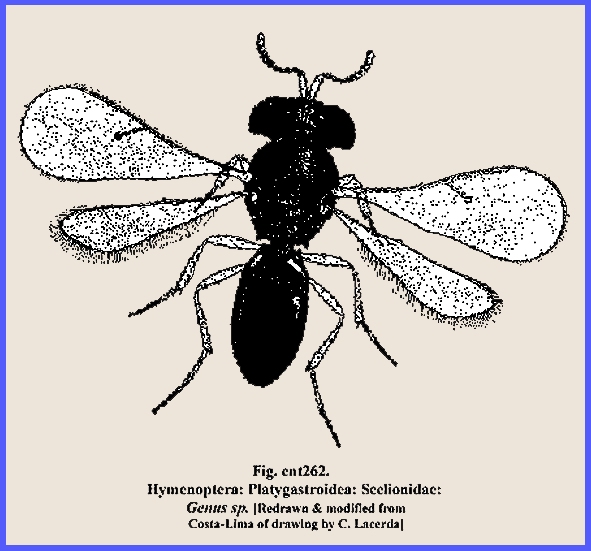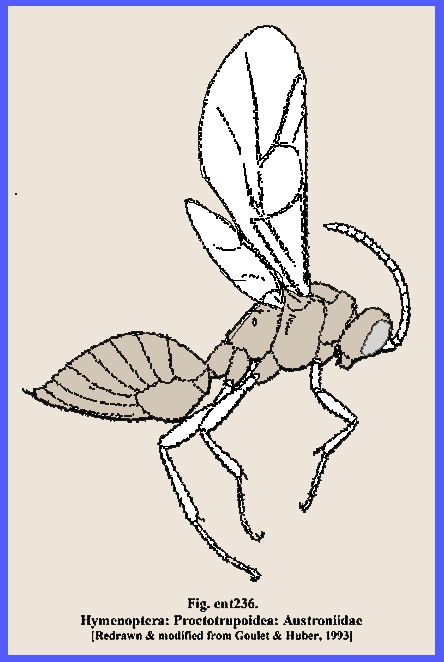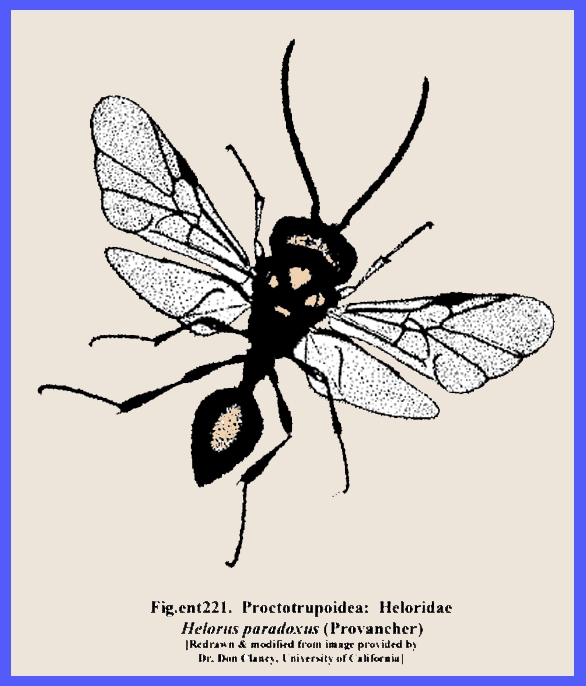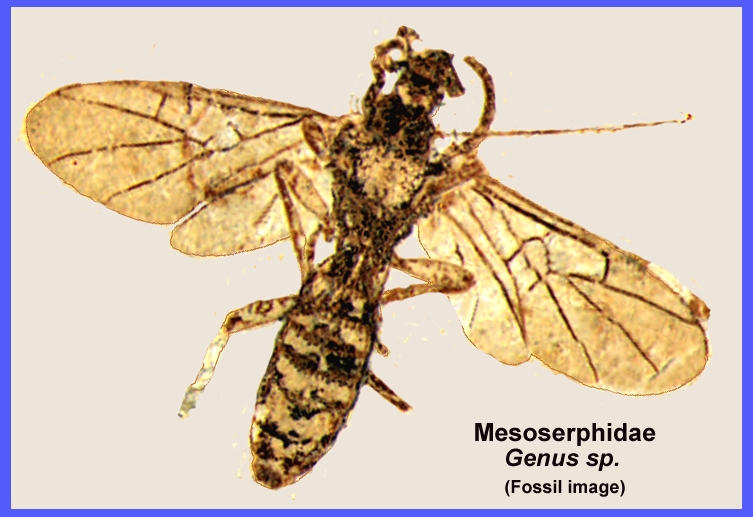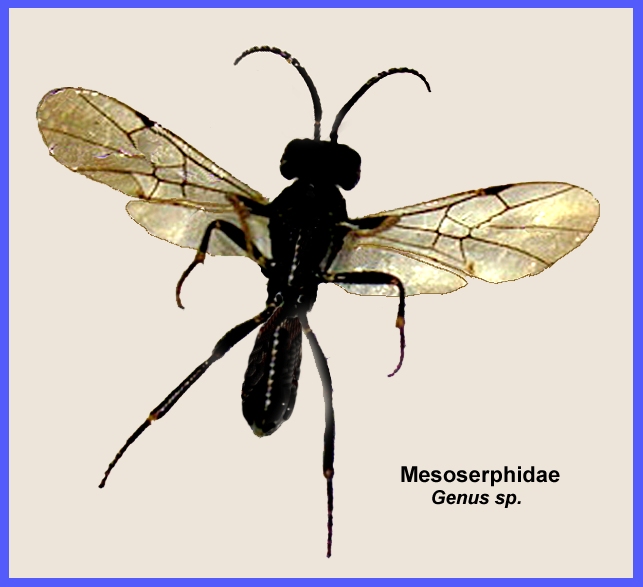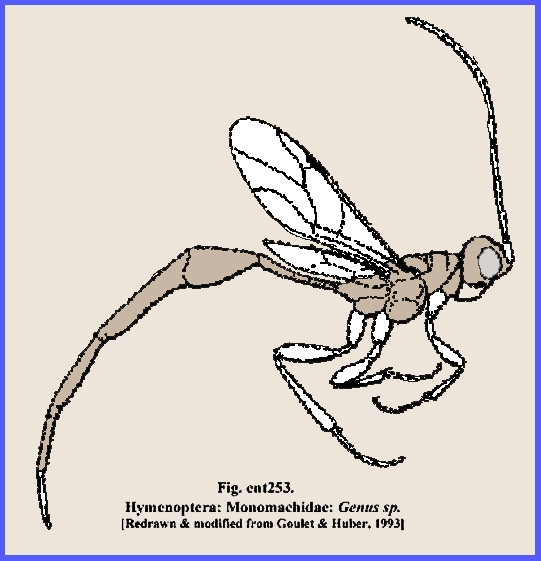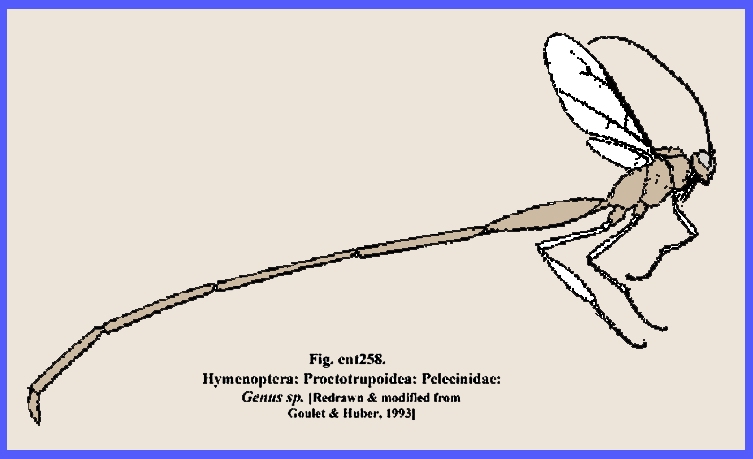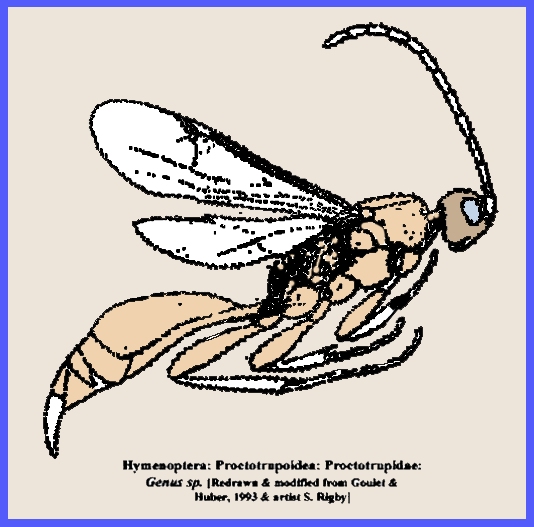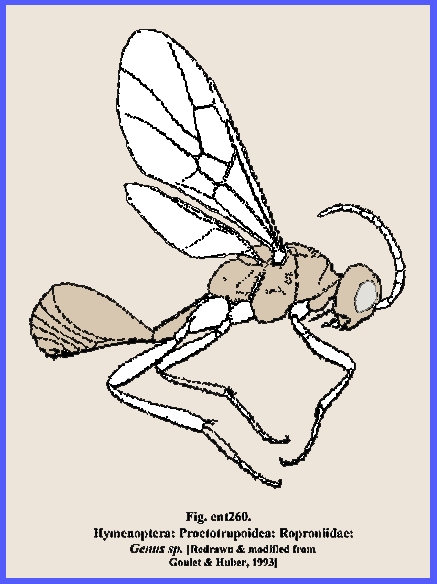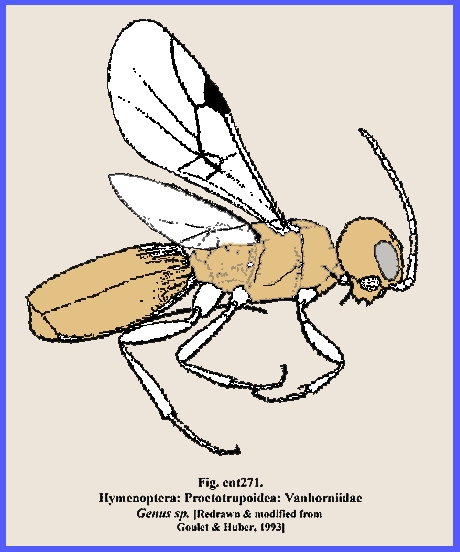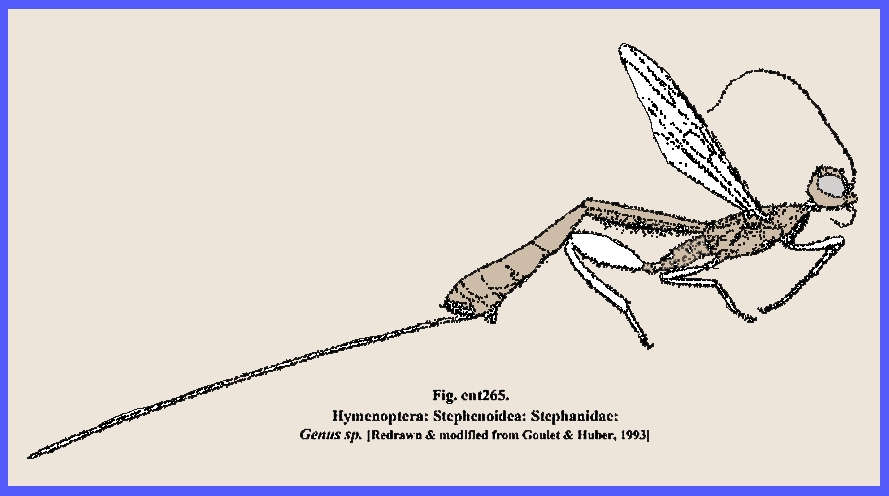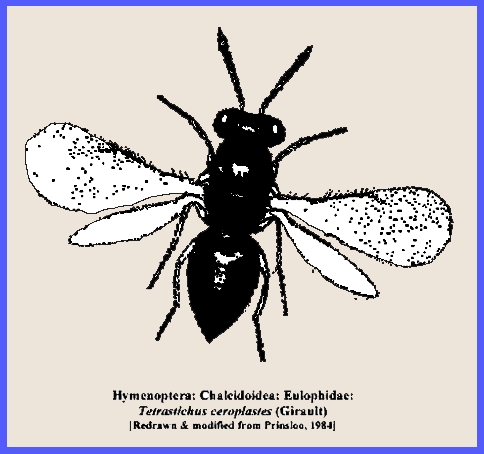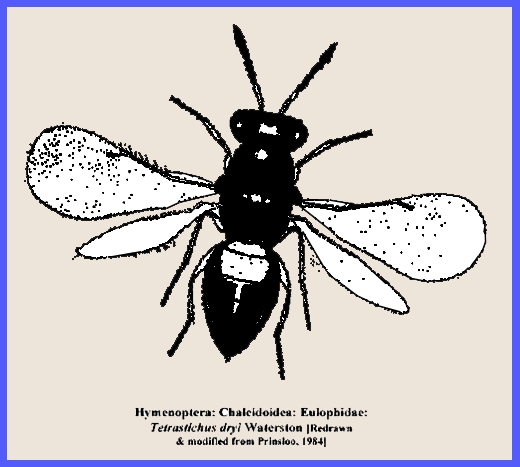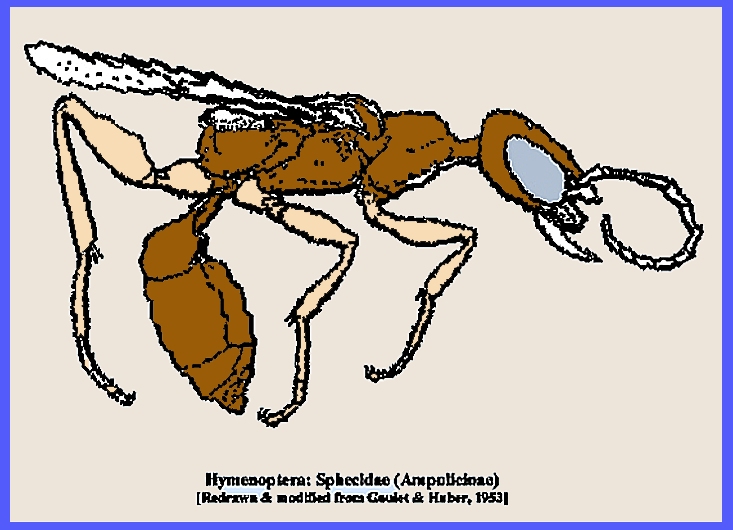File: <familyhy.htm> :
< (Entomology), (Invertebrates), (General Index)> <Invertebrate
Bibliography> <Glossary> <Site Description> < Home>
|
Entomology: HYMENOPTERA
1 Kingdom: Animalia, Phylum: Arthropoda Subphylum: Hexapoda: Class: Insecta: Order: Hymenoptera Selected Superfamilies,
Families & Subfamilies of Hymenoptera (Contact) Please CLICK on
Superfamily for Families and on included Illustrations to enlarge Depress
Ctrl/F to search for subject matter There are two suborders: Symphyta (Chalastogastra)
are the sawflies and Apocrita (Clistogastra)
are all other groups. The Symphyta have eruciform
larvae and their prolegs are without crochets may occur on all abdominal
segments. The adults have the abdomen
broadly joined with the thorax. The
ovipositor is adapted for piercing so that their eggs may be laid in hard
wood. There are many pestiferous
species in this group. The Apocrita contains the
largest number of species of Hymenoptera.
Their larvae are grub like without legs. Some develop as grubs on other animals and their mother
nourishes some. The adults have a
distinct petiole, and in some ant species both the second and third abdominal
segments may form the petiole. A node
is usually present. =
= = = = = = = = = = = = = = = = = = The following discussion includes
only the most common or important families or subfamilies of Hymenoptera. The
classification continues to fluctuate in this order, and therefore, older
names are included in parentheses for clarity as much of the world literature
deployed them. Additional information
on <Habits>,
<Adults>
and <Juveniles>
is included when available. For
greater detail please refer to Borror et al. (1989) and
<taxnames>,
and for an expanded treatment of Hymenoptera taxonomy with 92 families noted
please see <92
Families>. SYMPHYTA: Most Symphyta are
phytophagous external feeders on foliage. The larvae of the external feeders
are eruciform and differ from those of the Lepidoptera by having more than
five pairs of prolegs that lack crochets and usually have only one pair of
ocelli. The larvae of a few species bore in stems, fruits, wood, or leaves
(leaf miners); these larvae usually have the prolegs reduced or absent. All
the Symphyta have a prominent ovipositor, which is used in inserting the eggs
into the tissues of the host plant. In the Tenthredinoidea the ovipositor is
somewhat saw like, hence the common name "sawflies" for the members
of this group. Most of the Symphyta have a single generation a
year and overwinter as a full-grown larva or as a pupa, either in a cocoon or
in some sort of protected place. Most of the external feeders overwinter in a
cocoon or cell in the soil, while boring species usually do so in their
tunnels in the host plant. Some of the larger species spend more than a year
to complete their development (Borror et al. 1989). Superfamily: Cephoidea Cephidae.-- The Stem
Sawflies are slim, laterally
compressed sawflies. The larvae bore
in the stems of grasses and berries. Cephus cinctus Norton bores in the stems of
wheat and is known as the wheat stem sawfly. Adults average 8-10 mm in length, and are
shining black, banded and spotted with yellow. C. cinctus is a pest of
wheat in the western North America, while C. pygmaeus (L.), is
problematic in eastern parts of the continent. Janus
integer (Norton) bores in the stems of currants; the adult is
shining black and about 12 mm long.
There is one generation a year, and overwintering occurs in a silken
cocoon inside the plant where the larva feeds. -------------------------------- Superfamily: Megalodontoidea Pamphiliidae. -- Web-Spinning and
Leaf-Rolling Sawflies are
thick-bodied and I usually less than 13 mm long. Some have gregarious larvae
while others feed singly. The
gregarious species live in silk nests made by tying several leaves together,
and the solitary ones live in a shelter formed from a leaf. The group is
uncommon, and only a few of them are of much economic importance. Some
species are pests of conifers, Neurotoma inconspicua (Norton) (a web
spinning species) attacks plums, and Pamphilius persicum MacGillivray
(a leaf-rolling species) damages peaches. -------------------------------- Superfamily: Orussoidea -- Orussidae. -- <Overview>; <Adults> & <Juveniles> -- Parasitic
Wood Wasps
are a small group of rare
insects. The adults resemble
horntails but are much smaller (8-13 mm long). The larvae are parasitic on
the larvae of metallic wood-boring beetles (Buprestidae). -------------------------------- Superfamily: Siricoidea Siricidae. -- Horntails are
large insects, ca. 26 mm. or more long, and their larvae bore into wood. Both males and females have a spearlike
plate on the last abdominal segment.
They attack primarily coniferous trees, but hardwoods are also
selected. Their larvae do not cause
as much damage to trees as do other species in Symphyta. Most attack conifers, but those in
eastern North America also attack maple, elm, beech, and other hardwoods. The
larvae are not usually numerous enought to much damage. Pupation occurs in
burrows constructed by the larvae . -------------------------------- Superfamily: Tenthredinoidea Argidae. -- The argid sawflies are a small
group with 78 North American species known.
They are medium-sized to
small, robust sawflies, that are distinguished by the characteristic
antennae. The males of a few species
have the last antennal segment U-shaped or Y -shaped. Most species are black
or dark in color. The larvae feed on various
trees, but Arge humeralis (Beauvois) feeds on poison ivy, Sphacophilus
celluldris (Say) feeds on sweet potato, and Schizocerella pilicornis (Holmgren)
mines leaves of Portulaca (Borror & DeLong, 1954). -------------------------------- Blasticotomidae. -- There is one species, Blasticotoma
filiceti, in Europe. The larva
inhabits a cavity in the petiole of plant leaves, where it relies on the sap
that leaks from surrounding tissue.
In Belgium B. filiceti feeds on ferns with and produces a
conspicuous foam at the larval stage. -------------------------------- Cimbicidae. --
Cimbicid sawflies are large, heavy sawflies
with clubbed antennae. They resemble bumblebees. The most abundant species is
the elm
sawfly, Cimbex americana Leach, a
dark colored insect 16-26 mm long.
Females have four small yellow spots on each side of the abdomen. The
full-grown larva is about 42 mm long, and a black stripe down the back. When
at rest or when disturbed, it forms a spiral posture, but when disturbed, it
may eject a fluid, from glands located
above the spiracles. This species has one generation a year and
overwinters as a full-grown larva in a cocoon in the ground; it pupates in
the spring, and adults appear in summer. The larva attacks elm and willow
primarily. -------------------------------- Pergidae. -- Pergid sawflies are a small group with only 15
North American species identified.
They occur from the eastern
states west to Arizona, but are uncommon.
The larvae feed on the foliage of oak and hickory. American species belong to the genus Acordulecera. -------------------------------- Tenthredinidae. -- <Overview>;
<Adults> The
common sawflies
or horntails
are broad-waisted insects that lay their eggs in wood. It is a large group of wasp like species
that are frequently vibrantly colored.
They are encountered around flowers and other plant foliage. Their size usually does not exceed 21 mm
long. The eruciform larvae feed
externally on foliage but some bore into hardwood. They will leave their burrows to feed on tree foliage. Most have one generation per year and they
overinter in a cocoon or pupal cell that is located in some protective area
or in the ground. Some sawflies are very
destructive. The larch sawfly, Pristiphora
erichsonii (Hartig), is a pest of larch and, when abundant
they can cause extensive defoliation. The imported
currantworm, Nematus ribesii (Scopoli) ,
is a serious pest of currants and Gooseberries (Borror
& DeLong, 1954). Several species construct galls, and a few are leaf miners.
The elm leafminer, Fenusa ulmi Sundeval,
mines the leaves of elm trees. The Cherry slug feeds on leaves
leaving only a network of veins.
Their distribution is widespread in North America. There are two generations per year, but
the second generation does the most damage.
These insects are very susceptible to most insecticides. -------------------------------- Diprionidae. -- The Conifer
sawflies larvae attack conifers but
only a few of them are of economic importance. Some are web spinners that feed on plum trees or
leaf rollers that feed on peach trees.
The females have pectinate and males have bipectinate antennae. -------------------------------- Xiphydriidae. -- The Xiphydriidae are a family of wood wasps
with 28 genera and 14 species and some fossil taxa. They have globose heads borne on long, thin "necks";
they are unusual in the habit of boring into dead wood, rather than living
trees. The family is small and
ancient, with about 140 living species in several genera. They are primarily confined to the
Northern Hemisphere and only a few are Neotropical species. Taeger, A.;
Liston, A.D.; Prous, M.; Groll, E.K.; et al. (2018). "ECatSym –
Electronic World Catalog of Symphyta (Insecta, Hymenoptera)".
Senckenberg Deutsches Entomologisches Institut (SDEI), Müncheberg. Retrieved
2019-06-01. Jennings, J.T.,
Austin, A.D. and Bashford, R. (2009). First record of the woodwasp family
Xiphydriidae from Tasmania with a description of a new species and host
record. Australian Journal of Entomology 48: 25-28. -------------------------------- Superfamily: Xyeloidea Xyelidae. -- The small
sawflies are
less than 11 mm. long. They differ from
other sawflies in having three marginal wing cells and the third antennal
segment being very long. The larvae feed on the wood and pinecones of various
trees, but the damage that they cause is slight compared to other members of
the Symphyta. There are not many species and
none are of much economic importance. -------------------------------- APOCRITA:
-- The Apocrita differ from the Symphyta in having
a constricted base of their abdomen.
The thorax appears as for segments with the propodeum being the first
abdominal segment fused with the thoracic segments. The hind wings do not have more than two basal cells. The
larvae are usually grub like or maggot like and vary in feeding habits; some
are parasitic or predatory on other insects, while others are phytophagous.
The adults feed primarily on flowers, sap, and other plant materials; some of
the parasitic species occasionally feed on the body fluids of the host in a
behavior Known
as "host feeding." Many species in this are
parasitoids in the larval stage on other insects (or other invertebrates)
and, because of their abundance, are very important in the natural balance of
insect populations. Most of the parasitic Apocrita lay their eggs on or in
the body of the host, and many have a long ovipositor with which hosts in
cocoons, burrows, or other protected situations may be reached. In some cases
only a single egg is laid on a host; in others, several to many eggs may be
laid on the same host. A single parasitoid attacking a host usually pupates
inside the host; where there are many parasitoids in the same host, they may
pupate inside it, on the outside of it, or entirely away from it. Some
species are parthenogenetic. Polyembryony is found in a few species. Some of
the parasitic species are hyperparasitoids (Borror et al. 1989). Aculeata =
Stinging
Hymenoptera Superfamily: Apoidea. -- <Overview> [Incl. old Sphecoidea] Andrenidae. -- <Habits>; <Adults> & <Juveniles> -- The mason
bees are small to medium-sized
bees that are distinguished by two subantennal sutures below each antennal
socket. There are about 1300 species
known to exist in North America They nest in burrows in the ground, and their
burrows are similar to those of the halictids; sometimes large numbers of
these bees will nest close together in areas where there is little
vegetation. -------------------------------- Apidae: Apinae:
-- <Habits>; <Adults>
& <Juveniles> -- The honeybees always produce a
wax comb with hexagonal cells. The cells serve for larval rearing sites and
honey storage. Honey is formed in the
stomach from nectar through the action of enzymes. It is regurgitated into the storage cells. The developing brood is fed with
pollen. The queen is responsible for
the production of eggs. She produces
a "queen substance" that suppresses
the development of other females in the colony. A marked division of labor occurs
in the colony. The drones exist
solely for the purpose of mating with the queen. There is a continuous cycle in a colony, and a division takes
place when a second queen is produced.
The old queen then leads a part of the old colony away to a new site
in a swarm. Three principal stimuli to the production
of new queens are, (1) when an overabundance of individuals occurs in the
hive, (2) an old queen dies and (3) when there is a shortage of food. The latter case stimulates swarming to
form new colonies. Apiculture regularly includes
artificial insemination. The genetic
configuration of a queen is 2X, a worker 2X and a drone 1X. Drones are produced from unfertilized
eggs. Honeybees are of great economic
importance in that they are widely deployed for the pollination of both
orchard and field crops (Please see Insect
Pollination). Bee venom has been used in therapy and royal
jelly
has been touted for rather
doubtful rejuvenation properties. -------------------------------- Anthophorini (previously
under Anthophoridae). -- <Habits>; <Adults> Digger bees
are
robust and hairy and collect pollen from various plants. They nest in the ground and line their
cells with a waxy material. Some
species are parasitic on other bees. -------------------------------- Bombini
(Bombidae).-- Bumblebees, of Western Hemispheric
origin, are easily recognized by their large robust shape and yellow and
black stripes. Some species also
display orange coloration. They are
important and efficient pollinators of clover and alfalfa. They have been introduced successfully
into Europe. Their nests occur in the ground, and in colder climates
only the queen survives the winter.
In springtime the queen chooses a nesting site and produces a brood of
all workers, which assume all the chores of a colony except egg laying. They slowly enlarge the nest, collect and
store food, create honey pots,
and tend the young larvae. Males and
more queens are produced in summer and in autumn all but the queens will
perish. Some genera of bumblebees are parasites of other
bumblebees and they rely on other species to manage colonies -------------------------------- Xylocopinae (previously under Anthophoridae).
-- (= Nomadidae) <Habits>; <Adults> Carpenter bees do
not have a protuberant clypeus, the front coxae are transverse, and the last
abdominal tergite lacks a triangular platelike area. They construct nests in plant stems and wood. They resemble bumblebees in size and the
noise they make while in flight.
Damage is considerable to the exterior portion of wooden structures as
a result of their affixing nests there. -------------------------------- Nomadinae (previously under Anthophoridae).-- <Habits>; <Adults>
-- & <Habits>;
<Adults>
& <Juveniles>
-- These are the cuckoo bees,
which are parasites in the nests of other bees. They resemble wasps in that their bodies are relatively free of
hairs. -------------------------------- Colletidae. -- <Habits>; <Adults> The
Plasterer
bees
and Yellow-faced
bees
are a primitive group with
short tongues that are either bilobed at the tip or truncate. -------------------------------- Ctenoplectridae.
-- Habits; Adults
Juveniles There were 21 species known as of 2020 of these bulky, medium-sized to
small bees. They exist in Africa and
tropical and eastern Asia, south to northern Australia. Nests are in wood burrows or in old mud
nests of wasps. The mentum and
lorum is similar to that of the Melittidae (Finnamore & Michener
1993). Michener & Greenberg
(1980) reviewed the family associations. -------------------------------- Fideliidae.
-- Habits; Adults Juveniles Fideliidae are
long-tongued bees with a labrum that is longer than broad. The mandibles contain many teeth and anre
not wide and the forewings have three submarginal cells. These bees do not carry pollen on their
hind legs (Finnamore & Michener 1993).
The family had about 18 species identified by 2011, and it is
sometimes placed in the Megachilidae.
They nest in soil burrows and do not supply them with debris. Three genera occur only southern Africa,
Morocco, and central Chile (Finnamore & Michener 1993). -------------------------------- Halictidae. -- <Habits>; <Adults> & <Juveniles>
-- The sweat bees
are
small to moderately sized bees that have a metallic sheen. Their harched basal wing vein
distinguishes them. Most nest in
ground burrows, either on level ground or in river banks. Their principal tunnel is often vertical
with lateral tunnels that branch out to end in a single cell. -------------------------------- Hylaeidae. -- Habits;
Adults
Juveniles Clausen (1940) considered this family under the Apoidea, noting
that they were a small family of primitive bees that make their nests in
stems of plants, in burrows in the soil, or in various holes and
crevices. Several members of the
principal genus Hylaeus (Prosopis) have been observed in Hawaii
by Perkins and are stated to live at the expense of other bees of the family,
although the exact relationships were not known. -------------------------------- Megachilidae. --
<Habits>; <Adults> Leafcutting
bees
are moderately sized
insects that are distinguished from most other bees in having two submarginal
cells of about equal length. They
line their nests with pieces of plant leaves that they often cut in circular
fashion. Some species are
parasitic. Their nests occur in the
ground or some suitable cavity and in wood.
Some species are valued in the pollination of alfalfa. The common name originates from
the habit of many lining their nests with pieces cut from leaves. These
pieces are usually very carefully cut out, and it is not unusual to find
plants from which circular pieces have been cut. A few species are parasitic.
The nests are constructed in the ground but more often in some natural
cavity, and often in wood. -------------------------------- Melittidae. -- <Habits>; <Adults> Melittids
are small, dark bees that are not very often encountered as they are
relatively rare. They have similar
nesting habits to the Andrenidae. They are distinguished by having the jugal
lobe of the hind wing shorter than the submedian cell, and the segments of
the labial palps are similar and cylindrical. North American species nest in
burrows in the soil. -------------------------------- Oxaeidae. -- Habits; Adults Juveniles Oxaeidae are large bees that have a short glossa and the
preepisternal groove below the scrobal depression is missing. The ocelli are positioned low on the face. There are basitibial and pygidial plates
present. (Finnamore & Michener 1993). This is often placed as the American subfamily Oxaeinae of the bee family Andrenidae, with large
13-26 mm, rapid-flying bees, frequently with large eyes. There are four
identified genera, with a total of 21 described species by 2011. They range from North America to
Argentina. The name Oxaeidae is frequently used, and treated as a family, but
they were changed to subfamily status by some specialists in 1995. A key reference is Hurd & Linsley (1976). -------------------------------- Sphecidae. -- <Habits>; Subfamilies of Sphecidae <Adults> & <Juveniles>
-- The mud daubers
have a very long
petiole. Most are moderate-sized to
large, with a complete wing venation, but a few are small with a length of
only 2 mm. The small sphecids have a reduced wing venation, with 4-5 closed
cells in the front wing. There are
over 1200 species of these solitary wasps in North America. There is the start of social
organization shown in some groups. Females construct their nests
attached to some object. Most species
nest in burrows in the ground, but some nest in natural cavities such as
hollow plant stems, cavities in wood, etc.
Some also construct nests of mud. They paralyze spiders, lay an egg
and seal the cell. The larvae
develop, pupate and chew their way out. There
is a restriction to a particular type of food for the larvae of some species,
but a few vary considerably in their selection of prey. Some are also
cleptoparasitic, building no nest but laying their eggs in the nests of other
wasps, their larvae feeding on the food stored for the host larvae. -------------------------------- Stelidae. -- Habits;
Adults
Juveniles Clausen (1940)
discussed bees in the Stelidae are inquilines in the cells of other bees,
principally Megachilidae. Clausen
(1940) noted that attack on the early stages of the host in the cell is
mainly for the purpose of eliminating a rival for the food supply. In Europe, Stelis nasuta Latr.
attacks the cells of Chalicodoma muraria F. (Fabre 1886). Such cells are made of a hard,
plaster-like substance, ca. 1 cm. thick, which the female must penetrate
before oviposition is possible. The
lid is removed with her mandibles, and several eggs are laid next to the
host. After ovipositing, the cell is
sealed by the stelid. The young
larvae of the host and stelid feed in the same area without interference; but
the Stelis larva develops more
rapidly and the host does not attain sufficient food to complete
development. In S. minuta Nyl., the
female lays the egg on the food material in the open cell of Osmia leucomeleana Kirby before the latter lays her egg (Verhoeff
1892). The Stelis egg hatches first, and for some time the two larvae feed
independently on the beebread, the parasitoid at the bottom and the host at
the top. Development of the former is
quicker and eventually the latter consumes the host larva. -------------------------------- Stenotritidae. -- Habits;
Adults
Juveniles The Stenotritidae is the smallest of all
formally recognised bee families, with only 21 species in two genera
known. All of them have been found
only in Australia. -------------------------------- -------------------------------- Superfamily: Chrysidoidea -- (Incl. old Bethyloidea) <Overview> Bethylidae. -- <Habits>; <Adults> & <Juveniles>
-- Bethylids are small to medium-sized,
dark-colored wasps; the females of many species are apterous and antlike in
appearance. In some there are both winged and wingless forms. They are parasitoids of the larvae of
Lepidoptera and Coleoptera and several species attack moths or beetles that
infest grain or flour. A few species will sting humans. Goniozus
legneri Gordh has been deployed successfully in the biological
control of navel orangeworm, Amyelois transitella (Walker) (See ch-77.htm). -------------------------------- Chrysididae.-- <Habits>; <Adults> & <Juveniles>
-- Cuckoo
wasps
are small insects, rarely over 11 mm long. Their color is metallic green or blue, and
usually the body is coarsely
sculptured. They resemble some of the
chalcids and bees in size and coloration, but a more complete venation
in the front wing but no closed cells in the hind wing distinguish the cuckoo
wasps. Also the structure of the
abdomen is distinctive and has only 3-4 visible segments and is hollowed
ventrally. When a cuckoo wasp is disturbed, it usually curls up in a ball.
Most species are external parasitoids of full-grown wasp or bee larvae; the
species in the genus Cleptes attack sawfly larvae, and those in Mesitiopterus
attack the eggs of walking sticks (Borror et al., 1989). -------------------------------- Cleptidae.
-- <Habits>; <Adults>
& <Juveniles> In 1940 Cleptidae was represented by
the genus Cleptes, in Europe, North
America and Asia (Clausen 1940/62).
Indeed, in general appearance and behavior, and undescribed species of
Cleptes from Korea, bore a close
resemblance to parasitic Chrysididae.
Clausen (1940) noted that several other species were reared from
sawfly cocoons in various parts of the world. Adult female Cleptes
sp. is very active, spending most of her time on the ground in search of
sawfly cocoons. When one is found,
she gnaws a hole in the cocoon wall, and the extensible ovipositor is
inserted by a backward thrust. The
3-jointed ovipositor is longer than the abdomen when extended. The egg is placed horizontally on the host
body in the mid-ventral curve of the abdomen but does not adhere. When oviposition is complete, the female
smears a quantity of mucilaginous material over the hole in the cocoon wall,
thereby sealing it. This spot of hard
glistening material can recognize parasitized cocoons. The oviposition behavior is almost
identical to that of Chrysis
shanghaiensis Smith, which
attacks cocoons of Lepidoptera (Clausen 1940/62). -------------------------------- Dryinidae. -- <Habits>; <Adults> & <Juveniles> -- These
are rare wasps, and in most species males and females are morphologically
distinct. Some females are wingless and resemble ants. The antennae have ten
segments, and the front tarsi of the female are usually pincerlike. The
peculiar -front tarsi of some females in this family are deployed for holding the host during
oviposition. Most dryinids are
parasitoids of nymphs and adults of Homoptera. Their larvae feed internally on the host, although during most
of their development a part of the body of the larva protrudes from the host
in a saclike structure. The parasitoid, when full grown, leaves the host and
spins a silken cocoon nearby. Polyembryony occurs in some species. -------------------------------- Embolemidae. -- <Habits>; <Adults> The biology of this group is not well studied. A Nearctic species was reared from
homopteran nymphs (Achilidae) feeding on subcortical fungi. Females have been
collected in ant nests and small mammal burrows. There are ca.. 22 species in 2 or 3 genera. Adults very tiny to small, solitary wasps. Antennal segments
are 10 in males and 13 in females. The geniculate antennae are inserted above
the lower margins of the eye. The
pronotum is short and does not extemd back to the tegulae. Cenchri are
absent, but wings may be either present or absent. The fore-wings have a prominent pterostigma; with the venation
well developed but reduced apically.
Forewing cells 6–10 are closed.
The hind wings do not have closed cells. Fore femora are either dilated or not. Hind femur do not have a
well developed trochantellus. The
hind tibiae have spurs that are seemingly specialized for a cleaning. The abdomen has a notable basal constriction. They may be either a long petiole, or
short-waist in females. There are 7 visible abdominal segments. The female ovipositer is conspicuous or
modified as a retractable stinging apparatus. The legs of the larvae may be
either present or vestigial. These
wasps are considered parasitic on unknown hosts that are selected by the
females. -------------------------------- Sclerogibbidae. -- <Habits>; <Adults> These wasps are distributed worldwide in warmer climates. There ae 14 African species in 3
genera. They are ectoparasitoids of
Embioptera nymphs. Pupations is in
the host web. They are solitary or gregarious ectoparasitoids of Embioptera
(webspinners). The larvae stay attached to the metasomal intersegmental
membranes of nymphal webspinners and pupate in the tunnels of their
host. Biological information is
scarce. Females are apterous while males are fully winged. They
vary in length from 2.2 - 6.5 mm, and are distinguished by the antennae
inserted just below a protruding shelf on the face; the antennae have 20 or
more segments. The head is triangular in lateral view and the front femur is swollen. Females have an hourglass-shaped mesosoma,
while the fore wing of males lacks a pterostigma and distal venation. The hind wing has no closed cells but a
large basal lobe. -------------------------------- CHRYSIDOIDEA DATA BEING OBTAINED Plumariidae
Habits; Adults Juveniles Scolebythidae
Habits; Adults Juveniles -------------------------------- Superfamily: Vespoidea (Incl. old Formicoidea, Pompiloidea, Scolioidea
& Tiphioidea)-- <Overview> Bradynobaenidae -- <Habits>; <Adults> There
were about 160 species in this family known as of 2010. Most of them occur in tropical areas. However, the family is absent from
Australasia. Adults are often hairy
and black, brown, reddish, or bicolored and sometimes marked with bands. The integument is often thick and hard,
and the females give a painful sting.
Sex associations are very difficult (Brothers & Finnamore
1993). All species are probably
solitary. Some information indicates
that the larvae are ectoparasitic on Solifugae (Arachnida) --------------------------------
Eumenidae (Eumeninae). -- <Habits>; <Adults> & <Juveniles>. -- The powder
wasps
construct mud or stick
shelters. The diagram shows a cross-section
of a burrow in a stem: The partitions
between the cells are very regular and curved. As the partitions are being laid down, the female back out of
the stalk. The larvae always orient themselves with their heads turned toward
the open end of the tube, which they detect by feeling the smooth, curved end
of the partition with their abdomen. These wasps sting many pest
insects to death, and can store 6-8 caterpillars in each cell. -------------------------------- Formicidae. -- <Habits>; <Adults> & <Juveniles>
--The ants exist
as many species and they are numerically very abundant. Polymorphism is pronounced. The various social orders in the family
have developed around a caste system.
This includes a queen, workers, soldiers, etc. The workers can appear in different shapes
and forms as influenced by nutrition and care among individuals of the
colony. All of the workers are
wingless. The abdomen in this group is rather soft and able to take on a
great deal of food, which other members of their colony are able to
solicit. They obtain it by stroking
the bearer who then regurgitates the food. Colony Establishment.
-- New males and females in the colony develop wings, after which they swarm
and mate. The females fall to the
ground and chew off their wings, while the males dies. The female then finds a suitable place to
construct a cell into which she will lay eggs. While waiting for the eggs to hatch, the female does not
feed. She derives nourishment by
absorbing internal body parts, such as wing muscles, etc. Some species such as the driver
and army ants are nomadic.
Conspicuous nests in the ground may be 2.7 meters or more below the
surface. Ants also may live in oak
acorns, dry stems, etc. Their food
includes seeds, dead insects, aphid honeydew and household foods. They may even take aphids into their nests
for the winter where they are attended. Ant control in houses is possible
with poison bait traps. The treatment
of concrete foundations with insecticides is a more drastic approach. -------------------------------- Mutillidae (velvet ants) -- <Habits>; <Adults> & <Juveniles> -- These
insects derive their name from the females, which are wingless and antlike
and are covered with dense hairs. The males are winged and usually larger
than the females and are also densely pubescent. Most species have "felt
lines" laterally on the
second abdominal tergum: narrow longitudinal bands of relatively dense,
closely oppressed hairs (Borror & DeLong,
1954). The females give a painful sting.
Some species can stridulate, and produce a squeaking sound when disturbed.
Most of the mutillids are external parasitoids of the larvae and pupae of
bees and wasps. Some also attack
beetles and flies. They are frequently found in open areas. This group is
large with about 480 North American
species identified as of 2010. Most
species occur in arid regions of South and Western North America. -------------------------------- Pompilidae (spider wasps) -- (= Psammocharidae) <Habits>; <Adults> & <Juveniles> -- The
pompilids ire thin glabrous wasps with long spiny legs, a quadrate pronotum,
and a typical suture across the mesopleuron.
The more common members are 14-26 mm long, but some species are 34-42 mm in length. Most spider wasps are dark-colored, with smoky
yellow wings; a few are brightly colored. The adults are
commonly found on flowers or on the ground where they search for prey. The
larvae of most species feed on spiders, from which they derive their common
name. However these are not the only
wasps that kill spiders. The spider wasps generally capture and paralyze a
spider and then prepare a cell for it in the ground, in rotten wood, or in a
crevice in rocks. Some spider wasps construct a cell first, and then hunt for
a spider to store in the cell. Some also attack the spider in its own cell or
burrow and do not move it after stinging and ovipositing on it. A few species oviposit on spiders that
have been stung by another wasp (Borror &
DeLong, 1954). The spider wasps are
fairly common insects with over 275 North American species identified as of
2010. Females have a very efficient
sting. -------------------------------- Rhopalosomatidae
-- <Habits>; <Adults> & <Juveniles>
--
There are two rare species that
occur in the eastern North America, Rhopalosoma nearcticum Brues and Olixon
banksii (Brues). R. nearcticum is 14.2-21 mm or more in length, is
light brown in color, and resembles ichneumonids of the genus Ophion, but
it does not have a compressed abdomen, the antennae contain only 12 (female)
or 13 (male) segments, and there is only one recurrent vein in the front wing
(Borror & DeLong,
1954). Ophion banksii is about 6.1 mm long
and has reduced wings that extend only to the tip of the propodeum. The
larvae of these wasps attack crickets. -------------------------------- Sapygidae
-- <Habits>; <Adults> & <Juveniles> -- This is are a small (19 North American species) and
rare group. The adults are of moderate size, usually spotted and black or
banded with yellow, and with squat legs. They are parasitoids of leaf cutting
bees (Megachllidae) and other wasps. -------------------------------- Scoliidae --
<Habits>; <Adults> & <Juveniles> -- These wasps are
similar to males of the Muullidae.
They are large, hairy, and usually black with yellow bands on their
abdomen. The larvae are external
parasitoids of the larvae of scarabaeid beetles. Adults are usually collected from flowers. The females burrow
into the ground to locate a host grub, which they sting and paralyze. They then burrow deeper into the soil and construct a cell
around the grub. Many grubs may be stung without the wasp ovipositing, but
these grubs usually do not recover. -------------------------------- Sierolomorphidae -- <Habits>; <Adults> These is a small (seven
North American species) but widely distributed group of shining black wasps
4.3-6.2 mm long. They are rare, and there have been few studies of their
immature stages. -------------------------------- Tiphiidae -- <Habits>; <Adults> & <Juveniles> --:
This is a large family, with over145 North American species, which are common
and widely distributed. They are black, medium-sized, and slightly hairy,
with small legs. The larvae are parasitoids of scarab beetle larvae; one
species, Tiphia popilliavora Rohwer, was imported to North
America for the biological control of the Japanese beetle. -------------------------------- Vespidae. --
<Habits>;
<Adults> & <Juveniles> -- The paper
wasps, hornets and
yellow
jackets
construct nests with cells
of paper. They are social insects
with a queen that is the only overwintering form. The workers are for food gathering and defense, while the males
serve only to mate with the females. -------------------------------- Parasitica. -- Many of the
Parasitica have been deployed in the biological control of other insects (Please see Biocontrol) Superfamily: Ceraphronoidea--. <Overivew> Calliceratidae . --
<Habits>; <Adults>
& <Juveniles> This family is now generally placed
with the Ceraphronidae. However, it
has been reported as a small family with hosts in the Diptera, Hymenoptera,
Lepidoptera, Coleoptera and Homoptera.
They are more generally found as secondary external parasitoids of
Aphididae and dactylopine Coccidae, through Braconidae and chalcidoid
primaries. Calliceras abnormis
Perk. attacks mature dryinid larvae in their cocoons in Hawaii, and Lygocerus semiramosus Kieff, is a secondary parasitoid of Chermidae through
Encyrtidae in India (Clausen 1940/1962).
Specimens found in amber have been assigned to this family also, an
example of which follows: -------------------------------- Ceraphronidae --.
<Habits>; <Adults> & <Juveniles> -- This is a large group whose
members have been reared from a variety of hosts. Some ceraphronids are
hyperparasitic, attacking the braconid or chalcid parasitoids of aphids or
scale insects. Wingless forms in this group often inhabit soil and leaf
litter. --------------------------------
Megaspilidae
--. <Habits>; <Adults> The antennae in both male
and female Megaspilidae have an equal number of segments (Alekseev 1978/1987).
There is a receded area above the antennal sockets. The subcostal vein in front of the
pterostigma is usually thickened and forms the prostigma. Mesonotum in anterior part along sides sometimes
with two parallel grooves extending from median groove. Abdominal petiole masked by
"neck" and not visible unless abdomen removed. The abdomen is compressed
dorsoventrally. The male genitalia
have volsellar plates prominently separated from parameres." There were 10 species reported in Europe
as of 2010. These
small insects are only 2-3.2 mm long and they are are black or yellow;
macropterous, brachypterous or entirely wingless. The forewing has a large stigma (except in males of
Lagynodinae). The antennae have 9
flagellar segments in both sexes. The
metasoma has a constricted, collar. Very
little has been reported on their hosts and habits, but some species are
known to be primary parasitoids of
Coccoidea (Homoptera), Neuroptera, and puparia of Diptera, and some are
hyperparasitoids of Aphididae (Homoptera) through Aphidiinae
(Braconidae). One species in
California parasitizes Mecoptera (Boreidae).
There are two subfamilies:
Megaspilinae and Lagynodinae.
The former subfamily is cosmopolitan and has more than 11 genera; the
latter has two genera with dimorphic sexes.
There are more than 456 species described species worldwide as of
2010. -------------------------------- Superfamily:
Chalcidoidea -- <Overview>; <General References> -- This is a large Superfamily of
important insects that have been deployed successfully in biological control
worldwide. The number of species is
debatable but many specialists admit to being aware of only a fraction of
those still awaiting discovery. Their
taxonomy is often difficult as the characters used often show wide variation.
Most species are small or very tiny, some being less than 0.4 mm in long. Chalcids occur almost everywhere, but
because of their small size they are usually overlooked.. Their habitat is in
a variety of situations, principally on flowers and plant foliage. They
usually hold their wings flat over the abdomen when at rest, and many seem to
jump when they begin to fly. . Wing venation is a key diagnostic,
and the antennae are usually elbowed and never contain more than 13
segments. The pronotum is quadrate
and does not reach the tegulae, and there is usually a prepectus present on
the side of the thorax. Most of the
chalcids are dark to black in color, but many are blue or green in color with
a metallic sheen. Most species have
reduced wing venation, and there is a lot of variation in body shape. Some have peculiar, even bizarre, shapes.
The wings are reduced or absent in some groups. Most of the chalcids are
parasitoids of other insects, attacking the egg or larval stage of their
hosts. Most hosts are Lepidoptera, Diptera, Coleoptera, and Homoptera. Because these host groups contain many
agricultural pests, it is obvious that the chalcids are a valuable group for
natural control. Many species have been imported into different countries for
biological control. The larvae of few species are phytophagous feeding inside
seeds, stems, or galls.
Agaonidae
--. <Habits>; <Adults> There are two species of
fig
wasps,
Blastophaga psenes (L.) and Secundeisenia mexicana (Ashmead), in
North America, with B. psenes
having been introduced to allow for the production of some commercial figs. -------------------------------- The Smyrna fig, which is
grown in California, produces fruits only when it is pollinated with pollen
from the wild fig, or caprifig, the pollination being accomplished by fig
wasps. These develop in a gall in flowers of the caprifig. The blind and
flightless males emerge first and may copulate with females inside the galls.
The female, on emerging from the gall, collects pollen from male flowers of
the Capri fig and stores it in special baskets or corbiculae. The
female pollinates figs of both types (Smyrna fig and Capri fig), but
oviposits successfully only in the shorter flowers of the Capri fig. Fig
growers usually aid in the process of Smyrna fig pollination by placing in
the fig trees branches of the wild fig. -------------------------------- Aphelinidae.
--<Habits>;
<Adults> & <Juveniles> -- The group is valuable
in the biological control of other insects. -------------------------------- Chalcididae. --
<Habits>;
<Adults> & <Juveniles>
-- These are medium sized wasps about
2.2-8 mm long. Their hind femora are
swollen and bear teeth. The
chalcidids have antennae that are bent and very small. The body is laterally compressed. They are distinguished from the leucospidids
by having their ovipositor short and their wings not folded longitudinally
when resting. The eggs are produced parthenogenetically
at the rate of 300-400. The chalcidids are parasitoids of
Lepidoptera, Diptera, and Coleoptera, and some are hyperparasitoids that
attack tachinids or ichneumonids. The clover seed chalcid,
Bruchophagus platyptera (Walker),
is a serious pest of alfalfa seed and clover. Destruction can exceed 85 percent. The eggs are deposited through the seed pod, and only one larva
will develop per seed. Pupation
occurs in the seed. Control is
especially difficult and involves eliminating light where seed is stored, and
synchronizing seed production with periods of low pest activity. -------------------------------- (Elasmidae = old
category). -- <Habits>;
<Adults> & <Juveniles> -- Elasmus is the only Genus in what is presently the
subfamily Elasminae and there are about 205 species distributed
worldwide. They are mostly parasitoids or hyperparasitoids of Lepidoptera
larvae, but a few species are parasitoids of Polistes spp. larvae. --------------------------------
Encyrtidae.
-- <Habits>; <Adults-1> & <Adults-2>; & <Juveniles> -- This
is a large and worldwide group, with more than 372 North American species
known. They average 1.1-2.5 mm in length and are distinguished by a broad
convex mesopleura, whereas in most of the chalcids the mesopleura have a
groove for the femora, but this groove is absent in the encyrtids. The
encyrtids differ from the eupelmids by having a convex mesonotum convex and
lacking parapsidal furrows or have them but incomplete. Most species are
parasitoids of aphids, scale insects, and whiteflies, but there are also
species that attack insects in other orders. Polyembryony occurs in some of the species. --------------------------------
Eucharitidae.
-- (= Eucharidae) <Habits>;
<Adults> & <Juveniles> -- These
are distinctive in their appearance and habits. They are medium-sized, black
or metallic blue or green in color, with the abdomen petiolate and the
scutellum sometimes spined. The
thorax appears humpbacked. They are parasitoids of the pupae of ants The eggs are laid in large numbers
on the leaves or buds and hatch into tiny flattened larvae called planidia.
These planidia lie in wait on vegetation or on the ground and attach to
passing ants, which carry them to the ant nests. Once in the nest, the
planidia leave the worker ant that and attach to ant larvae; they do little
or no feeding on the larvae of the ant, but feed after the larva has pupated. --------------------------------
Eulophidae.
-- <Habits>; <Adults> & <Juveniles> -- This
is a large group with more than 125 North American species known. They are small insects averaging 1.2-4 mm
long. They parasitize a variety of
hosts that includes some major pests of agricultural crops. The 4-segmented tarsi and the axillae,
which extends forward beyond the tegulae, distinguishes them Many species are brightly colored and the
males of some have pectinate antennae. Some species are
hyperparasitoids, and there are some bizarre phenomena regarding
hyperparasitism and sex in the eulophids that attack scale insects. In the genus Coccophagus, the
females develop as parasitoids of scale insects, while the males develop as
hyperparasitoids attacking parasitoids of scale insects, which may even be
females of their own species. --------------------------------
Eupelmidae.
-- <Habits>; <Adults> & <Juveniles> -- This is a large family
with over 95 North American species known. They resemble encyrtids, but they
have a flatter mesonotum and parapsidal furrows are present. Some apterous or
have very short wings. Many are able to jump and they often tumble around after
jumping, before gaining a grip; their jumping is facilitated by their ability
to bend the head and abdomen up over the thorax, much as occurs in click
beetles. The members of this group attack a wide variety of hosts; a number
of species are known to attack hosts in different orders; and a few are
parasitoids of spiders. --------------------------------
Eurytomidae.
-- <Habits>; <Adults> & <Juveniles> -- The eurytomids resemble
perilampids by having the thorax coarsely punctated, but differ in that they
have the abdomen rounded or oval and compressed. They are black, with the
thorax, head, and antennae usually hairy.
They are more slender insects than the perilampids. Their habits vary with some being
parasitic and some phytophagous. --------------------------------
Leucospidae
(Leucospididae). --
<Habits>; <Adults> & <Juveniles> -- Leucospids are usually
black-and-yellow insects, and they are parasitoids of bees and wasps. They
are rare, but may sometimes be found on flowers. They are stout-bodied, have
the wings folded longitudinally at rest, and resemble small yellow jackets.
The ovipositor is long and curves upward and forward over the abdomen, ending
over the posterior part of the thorax. Like the chalcidids, the leucospidids
have the hind femora greatly swollen and toothed on the ventral side (Borror
et al. 1989). --------------------------------
Mymaridae.
-- <Habits>; <Adults> & <Juveniles> The fairy flies are
tiny insects, mostly less than a millimeter long, with linear hind wings.
They attack insect eggs, and some species attack the eggs of aquatic
insects. This group contains some of the smallest insects known; one species
of Aldptus has a body length of only 0.19 mm. --------------------------------
Ormyridae.
-- <Habits>; <Adults> Ormyridae resemble the
Torymidae, but have the parapsidal sutures indistinct or absent and have a
very short ovipositor. They are parasitoids of gall insects. --------------------------------
Perilampidae.
-- <Habits>; <Adults> & <Juveniles> -- Perilampids are stout
chalcids with a large thorax that is pocked.
Their abdomen is small, shiny and triangular shaped. Some species are metallic green that
resembles cuckoo wasps, while others are black. These wasps occur on flowers, and
most species are hyperparasitoids that attack Diptera and Hymenoptera which
are parasitoids of caterpillars. Some
attack free-living insects in various orders. Perilampus platygdster Say is a hyperparasitoid that
attacks Meteorus dimididtus Cresson, a braconid parasite of the grape
leaf folder. The perilampids, like the eucharitids, lay their eggs on
foliage, and the eggs hatch into larvae of the planidium type. The planidia remain on the foliage, attach
to a passing host and penetrate into its body cavity. If a hyperparasitic
species enters a caterpillar that is not parasitized, it usually does not
develop, but if the caterpillar is parasitized, then the perilampid larva
usually remains inactive in the caterpillar until the caterpillar parasitoid
has pupated, and then attacks the parasitoid. The perilampids regularly
attack the pupae of tachinids, braconids, or ichneumonids. --------------------------------
Pteromalidae.
-- <Habits>; Subfamilies of Pteromalidae <Adults>
& <Juveniles> -- The
PteromaIids are a large group of about 400 North American species. They are tiny black or metallic-green or
bronze wasps . They are parasitic and attack a wide variety of hosts with
many being valuable in the biological control of crop pests. The adults of
many species feed on the body fluids of the host, which exude from punctures
made by the parasite's ovipositor (see Photo #3 to the right below). [For
Subfamilies please see <nearct-2.key.htm>] In Habrocytus cerealellae (Ashmead)
that attacks larvae of the angoumois grain moth and where the host larvae are
in the seed and out of reach of the adult pteromalid, a viscous fluid is
secreted from the ovipositor that is then formed into a feeding
tube extending down to the host
larva. The adult sucks up the body fluids of the host through this tube. --------------------------------
Rotoitidae.
-- <Habits>; <Adults> This family is confined to
New Zealand, and there is very little information about the biology of its
members. Detailed information is
currently being acquired for this family --------------------------------
Signiphoridae. (Thysanidae)
-- <Habits>; <Adults> & <Juveniles> -- These are
small, thick-bodied chalcids that attack scale insects, whiteflies, and other
Homoptera or are hyperparasitoids of the chalcids that attack Homoptera. --------------------------------
Tanaostigmatidae.
-- <Habits>; <Adults> Four rare species in this
family are known from the Southwestern United States and Florida. The larvae are primarily gall makers. --------------------------------
Tetracampidae.
-- <Habits>; <Adults> This
is a small family wasps that are parasitoids of phytophagous insects,
primarily Diptera. There were 44 species identified by 2010, but they rare in
the Americas The males of many species
have 4 segmented tarsi, which is common in the Eulophidae), but females
always have 5 tarsal segments that is found in Pteromalidae. The antennae of
both males and females are like the Pteromalidae. There are many fossil
recoveries and their relationships to other Chalcidoidea are not well
studied. --------------------------------
Torymidae.
-- <Habits>; <Adults> & <Juveniles> -- Torymids
are elongated, metallic-green and average 2.2-4.5 mm long. There is a long ovipositor; the hind
coxae are large, and there are clear parapsidal sutures on the thorax. There are both parasitic and
phytophagous species: the TorylriInae, Erimennae, and Monodontomennae attack
gall insects and caterpillars; the Podagriorunae attack mantid eggs; and the
Idarrunae and MegastiglriInae attack seeds (Borror et al., 1989). -------------------------------- Trichogrammatidae.
-- Trichogrammatidae
<Habits>; <Adults> & <Juveniles> -- Trichogrammatids
are tiny insects, 0.3-1.1 mm long,.
The three-segmented tarsi, and the microscopic hairs of the wings that
are usually arranged in rows, distinguish them and the rather short head that
is somewhat concave posteriorly. The members of this group are parasitoids
attacking eggs of their hosts. Some species have been reared in large numbers
to aid in the control of orchard pests. -------------------------------- Superfamily: Cynipoidea. -- <Overview> -- This
group includes mostly small or tiny insects with a reduced wing venation .
Most species are black, and the abdomen is usually shiny and compressed. The
antennae are filiform, the pronotum extends back to the tegulae, and the
ovipositor issues from anterior to the apex of the abdomen. Austrocynipidae.
-- This
is one of the most rare groups of Hymenoptera that is native to Australia
with only one species, Austrocynips mirabilis. A pterostigma in the radial cell of the
forewing distinguishes it from other Cynipoidea. Also the posterior margin of the pronotum hangs over the
anterior margin of the mesopleuron.
The group was originally placed in a subfamily of Cynipidae, but it
now known to be phylogenetically basic to other members of the superfamily.
Austrocynips mirabilis was reared as a parasitoid from a Lepidoptera
moth in the cone of an Araucaria sp. belonging to the Family
Araucariaceae.
-------------------------------- Cynipidae.
-- Cynipidae
<Habits>; <Adults> & <Juveniles>. -- The gall wasps
are
divided into three subfamilies,
of which two (Eucoilinae
and Charipinae)
are parasitic and the third (Cyniplnae)
have gall makers or gall inquilines; a little over a hundred species of the
first two subfamilies occur in the United States, compared with some
640 Cyniplnae (Borror et al., 1989). Subfamilies: Cynipinae. -- Habits;
Adults
Juveniles The "gall wasps" are a large group, and many species
are quite common. They are small to minute, usually black insects that are
distinguished by their shape and wing venation. The abdomen is oval, compressed,
and shining, and the second tergum covers about half or more of the abdomen.
The Cynipinae differ from the Charipinae in that they are larger and the thorax usually has coarse
sculpturing. . Each species of gall maker forms a
characteristic gall in a particular part of a plant, the galls being much
more often noticed than are the insects. Many of the gall wasps form galls on
oak. Some galls harbor a single
insect, while many insects develop in others. The inquilines among the gall
wasps live in galls made by some other gall insect. Most of the gall wasps
are of little economic importance, but some of their galls have been used as
a source of tannic acid and others have been used as a source of certain
dyes. Many gall wasps have a complex
life history with two different generations a year. The summer generation is
spent in one type of gall, and the wasps, consisting entire of females emerge
in autumn. They reproduce
parthenogenetically. The eggs of this generation hatch and develop in a
different type of gall, and the adults that emerge in the early part of the
following summer contain both males
and females. Both the adult insects and the galls of these two generations
may be quite different in appearance (Borror et al., 1989). Eucoilinae. -- Habits; Adults Juveniles These are
distinguished by a rounded rise on the scutellum. They are all internal parasitoids of
dipterous larvae, emerging from the puparium. Many species inhabit the animal dung environment or are found
around rotting fruit. Most species
occur in the tropics, where they are very abundant. More than 77 species in
North American .Eucoilines have been reared from hosts from many habitats,
and several species have been reared from flies breeding in fruit. The most
reliable host records from Tephritidae are for the genera Aganaspis
and Odontosema. Many of the species reared from fruits are parasitoids
of Drosophilidae, Pnoridae Lonchaeidae, and other flies associated with ripe
and decomposing fruit. Charipinae. -- Habits; Adults Juveniles These are tiny insects, 2.1 mm long or less. They have a smooth thorax, and they are
hyperparasitoids, attacking braconids, which are aphid parasitoids. They
are hyperparasitoids of Hemiptera.The African genera Alloxysta and Phaenoglyphis are hyperparasitoids of Aphididae via Aphidiinae
(Hymenoptera: Braconidae) and Aphelinidae (Hymenoptera: Chalcidoidea).
Species of the African geners Apocharips and Dilyta are hyperparasitoids of Psyllidae via Encyrtidae (Hymenoptera:
Chalcidoidea). -------------------------------- Figitidae.
-- <Habits>; <Adults> These
are parasitoids of the pupae of lacewings
and Diptera. The family is
divided into three subfamilies, primarily on the basis of the structure of
the abdomen: the Anacharitinae, which have the abdomen distinctly petiolate
and the second tergum longer than the third ( ), attack the cocoons of
lacewings (Chrysopidae); the Aspiceratinae, in which the second abdominal
tergum is narrow and much shorter than the third, attack the pupae of syrphid
flies; the Figitinae, in which the second tergum is only slightly shorter
than the third , attack the pupae of various Diptera (Borror
et al., 1989). -------------------------------- Ibaliidae. -- Ibaliidae <Habits>; <Adults> The ibaliids are large
7-18 mm long and have the abdomen elongated.
They are parasitoids of horntails.
They are a rare group that is not often observed or collected. -------------------------------- Liopteridae.
-- Liopteridae
<Habits>; <Adults> These insects have a
petiolate abdomen which is attached above the bases of the hind coxae. Three
are rare species about which is very little known. -------------------------------- Superfamily:
Evanioidea. -- <Overview>
-- In this Superfamily the
abdomen is attached high above the hind
coxae, the antennae are filiform and have 13 or 14 segments. The trochanters have two segments, and the
front wing venation is usually
complete and there is a costal cell. Some (Gasteruptlidae and
Aulacidae) superficially resemble ichneumons. All are parasitoids of other
insects.
Aulacidae.
-- <Habits>; <Adults> Aulacids resemble
Gasteruptiidae, but they are more black with a red abdomen. The antennae are longer, and there are two
recurrent veins in the front wings.
They are parasitoids of the larvae of wood boring beetles and
xiphydriid wood wasps. Adults occur
around logs where they find their hosts. -------------------------------- Evaniidae. -- <Habits>; <Adults> & <Juveniles>. -- The ensign wasps are black, and resemble spiders. They average 10-16 mm long. The abdomen is
small and oval and is attached by a petiole to the propodeum much above the
base of the hind coxae ; it is carried almost like a flag (hence the common
name for this family.) These
wasps are parasitoids of the egg capsules of cockroaches and may be found in
buildings or other places where cockroaches roam. -------------------------------- Gasteruptiidae
(Gasteruptiidae).
-- Gasteruptiidae
<Habits>; <Adults> & <Juveniles> -- These
resemble ichneumonids, but they have shorter antennae and a costal cell in
the front wings. The head is
projected out on a neck. They have one submarginal cell or none and one
recurrent vein or none. They are
black insects, and the ovipositor of the female is about as long as the body.
Adults are common and are usually found on flowers, especially wild parsnip,
wild carrot, and related species. The larvae are parasitoids of solitary
wasps and bees. -------------------------------- Superfamily: Ichneumonoidea. -- <Overview> Apozygidae. -- <Habits>; <Adults> This
is a little studied family where there is only one Genus and two species
known from Chile, South America. -------------------------------- Braconidae. -- <Habits>; <Adults-1> & <Adults-2> & <Adults-3> & <Juveniles>. -- All
species of the braconids are parasitic on other insects. They sting the host and thereby paralyze
it. There are more than 1850 North
American species most of which are beneficial. The adults are all fairly
small rarely exceeding 16 mm in long.
Many are stout-bodied than the ichneumons, and the abdomen is about as
long as the head and the thorax combined.
They are similar to ichneumonids by lacking a costal cell, but they
differ by not having more than one recurrent vein. Many species are valued as natural controls of pest insects. Braconids and ichneumonids have
similar habits, but unlike the ichneumonids many pupate in silken cocoons on
the outside of the body of their hosts, while others spin silken cocoons
entirely apart from the host.
Polyembryony occurs in a few species, primarily in the genus Macrocentrus, each egg of M.
grandis Goidanich, a parasitoid of the European
corn borer, develops into from 16 to
24 larvae. Subfamily: Aphidiinae. -- <Habits>;
<Adults> The Aphidiinae are a subfamily of parasitic wasps that have aphids as
their hosts. The larva of Praon sp. exits from the hollowed shell of
the aphid to pupate in a cocoon, but most Aphidiinae pupate inside the dead
aphid. Some species have been
deployed for biological control of
aphids
Although they have been
considered as a separate family, the Aphidiidae, the Aphidiinae are now grouped with the Braconidae. Their
relationship to other braconid subfamilies is not fully understood. Aphidiines are
koinobiont endoparasitoids of adult and immature aphids. While the larva of
the 2–3 mm long Praon leaves the hollowed shell of the aphid from
below to pupate in a volcano-like cocoon, most other Aphidiinae pupate inside
the dead aphid and break out afterwards.
They range worldwide, but are mostly found in the Northern
Hemisphere. Several species have been
introduced to countries outside of their natural range, both accidentally and
purposefully for biological control. -------------------------------- Ichneumonidae. -- <Habits>; <Adults-1> & <Adults-2> & <Adults-3>; & <Juveniles>. -- The
ichneumonids are one of the most important parasitic insect groups and also
one of the largest in the Insecta.
There have been over 3400 species found in North America alone. The adults vary in size, form, and
coloration, but most resemble slender wasps.
They have a long, narrowed appearance, and there is a large stigma on
the forewing. They differ from the
stinging wasps by having antennae that are longer and with more
segments. Their trochanters are
2-segmented (1- segmented in the stinging wasps), and they a costal cell in
the front wings is absent. The ovipositor can
inject eggs into the host, which may be another ecto- or endoparasitoid. In many species the ovipositor is quite
long, often longer than the body, arising anteriorly to the tip of the
abdomen being permanently extended.
In the stinging wasps the ovipositor issues from the tip of the
abdomen and is withdrawn into the abdomen when not being used. The
ichneumonids differ from the braconids by having two recurrent veins whereas
the braconids have only one or none and in having an abdomen that is longer
than the head and thorax combined. In many species there is a considerable
difference in the appearance Between
males and females. The ichneumons attack a variety of
hosts, though most species attack only few kinds. There are few groups of
insects that are not hosts of some ichneumonid, and some species in this
family attack spiders. Most ichneumonids are internal parasitoids of the
immature stages of their hosts. The parasitoid may complete its development
in the stage of the host in which the egg is laid or in some later stage.
Subfamily:
Agriotypinae. -- Habits; Adults Juveniles This is is a Palaearctic subfamily of the parasitic
Ichneumonidae. Agriotypus is
the only genus in the group .The
known species are aquatic ectoparasitoids of Trichoptera pupae. The placement Agriotypus is not
clear as it has been classified with both the Proctotrupoidea and as a separate family of Ichneumonoidea. -------------------------------- Paxylommatidae. -- <Habits>; <Adults> Paxylommatidae: the correct family-group name for Hybrizon
fallen (Hymenoptera: Ichneumonoidea), with figures of unusual antennal
sensillal. Species are being
described from Baltic and Rovno amber.
Van Achterberg, C. 1999. The West
Palaearctic species of the subfamily Paxylommatinae 9Hymenoptera:
Ichneumonidae), with special reference to the genus Hybrizon Fallen. Zool. Med. Leiden 73(2); 30.iv. 11-26,
figs. 1-42 -------------------------------- Superfamily: Megalyroidea. -- <Overview>
Megalyridae.
-- <Habits>; <Adults> Mason (1993) reported that
the Megalyridae are mainly parasitoids of Coleoptera larvae that are found
under tree bark. One species parasitizes
a species of Pemphredonidae. There
are about 11 species in Africa, South America, southeast Asia and Australia. The
body is sturdy and cylindrical (Mason 1993).
The gena has a large, spacious, oval pit where the antennal scape
occurs. The mesoscutum is flattened
and has large triangular axillae, and in most but one genus there is a
pronounced median groove that bisects the mesoscutum. -------------------------------- Superfamily: Mymarommatoidea (or Serphitoidea). -- Mymarommatidae.
-- (=
Callimomidae) <Habits>; <Adults> This
is a
very small family of tiny insects. Only 10 living species in 1 genus have
been described with others being known only as fossils. They had occurred worldwide. So that more are certain to be found. Nevertheless, they they are easily missed
and hardto study because of their small size of only 0.3 mm. long.
Little is known about the biology of these insects but because of
their size, and simple ovipositor, it is thought that they are parasitoids on
the eggs of other insects. They were originally placed as a subfamily of the
chalcidoid family Mymaridae but, because of morphological differences, are
now considered in their own superfamily, Mymarommatoidea, and their similarity to Mymaridae is probably a
case of convergent evolution.
There is no agreement as to the nearest living relatives of the
Mymarommatidae. It haas been
suggested that nearest relatives are the extinct family Serphitidae, and thus
the Mymarommatidae could be considered as "living fossils", a
surviving lineage of an extinct superfamily Serphitoidea. -------------------------------- Superfamily:
Platygastroidea Platygastridae.
-- (= Platygasteridae) <Habits>; <Adults> & <Juveniles> -- These are
tiny, shining-black insects with sparce wing venation so that they resemble
chalcids. The antennae usually have
10 segments and are attached very low on the face, next to the clypeus . Most
species are parasitoids of the larvae of
Cecidomylidae. Platygdster hiemalis Forbes has been successfully deployed
as a biological control the Hessian fly. Polyembryony occurs in some species,
with as many as 20 progeny emanating
from one egg. Most of the platygasterids are of average
appearance, insects, but the genus Inostemma are different in that
they have a long structure that arises from the dorsum of the first abdominal
segment and extends forward over the thorax, which serves as a sheath for the ovipositor. -------------------------------- Scelionidae. -- <Habits>; <Adults> & <Juveniles> -- Scelionids
are small insects that are parasitoids of insect or spider eggs. Some species have been successfully
deployed in the biological control of crop pests. The females of some
species, mainly those that attack the eggs of grasshoppers or mantids, attach
themselves to the female of the host species and ride on it until the host
lays its eggs, after which they depart from the host and attack its eggs. In
a few such cases the female may do some feeding on the adult of the host, but
usually the adult host serves only as a means of disemination. This behavior
is called phoresy
and is found also in the chalcid family
Eucharltidae -------------------------------- Superfamily: Proctotrupoidea. -- <Overview> -- All species in this
Superfamily are parasitoids that attack the immature stages of other insects.
Most are small or very tiny, black and shiny. They resemble chalcids, cynipids, or some of the scolioid or
bethyloids. The smaller species have a reduced wing venation like the
chalcids, but differ by the structure of the thorax and ovipositor. The pronotum is triangular in lateral view
and projects to the tegulae, and the ovipositor emanates from the tip of the
abdomen rather than from anterior.
Spome have their abdomen dorsoventrally flattened with the lateral
edges sharp. Proctotrupoids are not as widespread as the chalcids or
ichneumonids, and some are rare.
There are about 955 species known to occur in North America. Austroniidae. -- <Habits>; <Adults> Little is known about the
biology of these proctotrupids, but they are thought to be parasitoids of
other insects. There is only one described genus with 3 species, all from
Australia -------------------------------- Diapriidae. -- <Habits>; <Adults> & <Juveniles> -- Diapriids
are small to tiny black insects, most of which are parasites of immature
Diptera. The form of the head distinguishes them; the antennae arise on a
shelf like projection in about the middle of the face. These insects occur near the
ground in wooded areas, for they attack fungus gnats (MycetophIlidae) and
other flies breeding in fungi. Some species have been introduced into
California for the biological control of Hippelates
eye gnats (see ch-20.htm). -------------------------------- Heloridae.
-- <Habits>; <Adults> & <Juveniles> -- There is but one North
American species known, Helorus paradixus (Provancher), a black insect
about 4.5 mm long with a more or less complete venation in the front wings.
This species is a Parasite of the larvae of chrysopid lacewings. Adults emerge from the host's cocoon. -------------------------------- Maamingidae. -- Little is
known of the biology of this family save that it has been collected from
isolated islands near New Zealand.
There are two genera with two described species. A good references is: Early, J. W., L. Masner, I. D. Naumann
& A. D. Austin. 2001. Maamingidae, a new family of proctotrupoid wasp
(Insecta: Hymenoptera) from New Zealand. Invertebrate taxonomy, 15: 341-352. -------------------------------- Mesoserphidae. -- These are
parasitoids of immature stages of other insects. Most species are small
black, and may often be confused with cynipids or chalcidoids. The smallest
species have a reduced wing venation, but they may be separated from
chalcidoids by the structure of the mesosoma and ovipositor. The pronotum in
the proctotrupoids is more triangular when viewed laterally and it extends to
the tegulae. The ovipositor emanates from the tip of the metasoma rather than
from anterior to the tip A good reference is : Rasnitsyn A.P. 1986. New hymenopterous
insects of the family Mesoserphidae. Vestnik zool. 2: 19-25 (in Russian). --------------------------------
Monomachidae. -- <Habits>; <Adults> The body of members of
this family is about 9.5-11.2 mm long (Masner 1993). They are sexually dimorphic. Females have a sickle-shaped attenuated
metasoma, males have a pedunculate metasoma.
The mandibles are very huge.
The pronotum has a sharp transverse ridge that is capable of sliding
over the anterior part of the mesoscutum.
The propodeum is cone-shaped, without a median keel. The metacoxa is inserted relatively remote
from the propodeal foramen. The
forewing usually has 5 closed cells and a relatively narrow stigma. The metasomal segment 1 (petiole) is very
long and slender, and metasomal tergum 2 consists of 1 tergum that is not the
longest segment. The ovipositor is
extremely short, concealed insider the metasomal segment 8. Some Neotropical species are light
green and a few multicolored. In
Australia one species has been reared from Stratiomyidae (Diptera). Adults of the Australian species are
active during winter. In 2
undescribed Neotropical species (from Peru and Chile) the female is
micropterous. The family has 2 genera
and ca. 20 rare species, mostly in the New World tropics (Guerrero, Mexico to
Argentina and Chile), with only a few additional ones in Australia and New
Guinea. They are all apparently of
Southern Hemispheric origin. Some references are: Musetti, L.; Johnson,
N.F. 2000: First documented record of Monomachidae (Hymenoptera: Proctotrupoidea)
in New Guinea, and description of two new species. Proceedings of the
Entomological Society of Washington, 102: 957-963. Musetti, L. & N. F.
Johnson. 2004: Revision of the New World species of the genus Monomachus
Klug (Hymenoptera: Proctotrupoidea, Monomachidae). Canadian entomologist,
136: 501-552. Naumann, I. D. 1985: The Australian species
of Monomachidae (Hymenoptera: Proctotrupoidea), with a revised diagnosis of
the family. Journal of the Australian Entomological Society, 24: 261-274. -------------------------------- Pelecinidae. -- <Habits>;
<Adults> & <Juveniles> --
These parasitize the larvae of Phyllophaga
spp. (Coleoptera: Scarabaeidae) There are three species known in one genus (Pelecinus),
which are distributed in the Western Hemisphere. There is only one North American genus with one species: Pelecinus
polyturator Drury. Worldwide, there is only one extant genus, Pelecinus,
with three recognized species (Galloway 2008): -------------------------------- Peradeniidae. --
<Habits>; <Adults> The biology of these
proctotrupids is unstudied, but they have been collected during the winter
months in Australia. There is one
genus, Peradenia, with two species. -------------------------------- Proctorenyxidae.
-- The biology of these wasps remains unstudied, but they are believed to be
parasitoids on other insects. There is one genus with one
described sp.: Proctorenyxa incredibilis. -------------------------------- Proctotrupidae. -- (= Serphidae) <Habits>; <Adults> & <Juveniles>; Serphidae (now with Proctotrupidae) <Habits>; <Adults> Most Proctotrupids range
in size from 3 to 7 mm long. They are
distinguished by a large stigma in the front wing, beyond which is a very
small marginal cell. Some species are
parasitoids of beetles, and flies. -------------------------------- Roproniidae. -- <Habits>; <Adults> There are three rare North
American species of Ropronia. The adults are 8-12 mm long and have a
laterally flattened, triangular and petiolate abdomen and a more or less
complete venation in the front wing . The immature stages are parasitoids of
sawflies. -------------------------------- Vanhorniidae. -- <Habits>; <Adults> & <Juveniles> -- There
is a single North American species, Vanhornia
eucnemidarum Crawford, which is a parasitoid of the larvae of
eucnemid beetles. -------------------------------- Superfamily: Stephanoidea. -- <Overview> Stephanidae.
-- Stephanidae
<Habits>; <Adults> Stephanids are a small of
rare hymenopterans that are parasitoids of the larvae of wood-boring beetles.
The adults vary in length from 4-20 mm.
They are slim and resemble ichneumonids with their long ovipositor.
The head is quite spherical, and protrudes on a neck. It also has a crown of about four or five
teeth around the median ocellus. The
hind coxae are long, and the hind femora are swollen and also have teeth.
Most American species occur in the western Nearctic. -------------------------------- Superfamily: Trigonaloidea. -- <Overview> Trigonalidae.
-- <Habits>; <Adults> & <Juveniles> -- Trigonalids
are a small group of rare hymenopterans of average size and quite brightly
colored. Their bodies are stout and
they resemble wasps, but have long and multisegmented antennae. Trigonalids are parasitoids of
Vespidae or hyperparasitoids of caterpillars. The very small eggs are laid in
large numbers on plant foliage. In the case of the species attacking
caterpillar parasites, the eggs hatch when eaten by a caterpillar, and the
wasp larvae attack the ichneumon, tachinid, or other parasitoid larva that may
be present. In the species that attack vespid larvae, the eggs are eaten by a
caterpillar, which is in turn eaten by a vespid wasp, which in regurgitating
the caterpillar and feeding it to its young, transfers the trigonalid larvae
from the caterpillar to the wasp larvae (Borror & DeLong,
1954). = = = = = = = = = = = = =
= = = Hymenoptera
Most Common in the Neotropics Paxylommatidae. -- <Habits>; <Adults> The correct family-group name for Hybrizon fallen
(Hymenoptera: Ichneumonoidea), with figures of unusual antennal
sensillal. Species are being
described from Baltic and Rovno amber.
Van Achterberg, C. 1999. The West
Palaearctic species of the subfamily Paxylommatinae 9Hymenoptera:
Ichneumonidae), with special reference to the genus Hybrizon Fallen. Zool. Med. Leiden 73(2); 30.iv. 11-26,
figs. 1-42 -------------------------------- Entedontidae. -- Species in this
family have been bred from the larvae of the Rice Leaf Miner (Diptera:
Agromyzidae). Studies are conducted
at the Universidad Nacional de La Plata in Argentina.
-------------------------------- Tetrastichidae . -- Biological studies are
conducted on Tetrastichus schoenobii
Ferriere, which is an egg parasitoid of the yellow rice borer, Scirpophaga
incertulas (Walker). -------------------------------- Sclerogibbidae. -- <Habits>;
<Adults> These wasps are distributed worldwide in warmer
climates. There ae 14 African species
in 3 genera. They are ectoparasitoids
of Embioptera nymphs. Pupations is in
the host web. They are solitary or gregarious ectoparasitoids of Embioptera
(webspinners). The larvae stay attached to the metasomal intersegmental
membranes of nymphal webspinners and pupate in the tunnels of their
host. Biological information is
scarce. Females are apterous while males are fully winged. They
vary in length from 2.2 - 6.5 mm, and are distinguished by the antennae
inserted just below a protruding shelf on the face; the antennae have 20 or
more segments. The head is triangular in lateral view and the front femur is swollen. Females have an hourglass-shaped mesosoma,
while the fore wing of males lacks a pterostigma and distal venation. The hind wing has no closed cells but a
large basal lobe. -------------------------------- Cleptidae. -- <Habits>; <Adults>
& <Juveniles> In 1940 Cleptidae was represented by
the genus Cleptes, in Europe, North
America and Asia (Clausen 1940/62).
Indeed, in general appearance and behavior, and undescribed species of
Cleptes from Korea, bore a close
resemblance to parasitic Chrysididae.
Clausen (1940) noted that several other species were reared from
sawfly cocoons in various parts of the world. Adult female Cleptes
sp. is very active, spending most of her time on the ground in search of
sawfly cocoons. When one is found,
she gnaws a hole in the cocoon wall, and the extensible ovipositor is
inserted by a backward thrust. The
3-jointed ovipositor is longer than the abdomen when extended. The egg is placed horizontally on the host
body in the mid-ventral curve of the abdomen but does not adhere. When oviposition is complete, the female
smears a quantity of mucilaginous material over the hole in the cocoon wall,
thereby sealing it. This spot of hard
glistening material can recognize parasitized cocoons. The oviposition behavior is almost
identical to that of Chrysis
shanghaiensis Smith, which
attacks cocoons of Lepidoptera (Clausen 1940/62). -------------------------------- Ampulicidae. -- (= Ampulicinae)
<Habits>; <Adults>
& <Juveniles> This family frequently treated as the subfamily Ampulicinae of the Sphecidae, contains species that seldom dig burrows, but rather utilize
natural cavities for nests, which are provisioned with immature
cockroaches. Williams (1919b)
described the behavior of Dolichurus
stantoni Ashm., which attacks
nymphs of several genera of cockroaches.
The agile cockroaches are located by the female who grasps one by a
cercus or leg, and then stings it in the throat or thorax. As only partial paralysis ensues, the
cockroach is able to continue slow movement.
Then the wasp grasps an antenna near the base and leads or drags the
prey to the nest (Clausen 1940/1962).
The female positions the prey in the nest, and lays an egg rather
obliquely on one of the middle coxae.
After hatching in 1-2 days, the larval feeding period is completed in
4-5 days. D. stantoni as
introduced to Hawaii from the Philippines in 1917 and became well
established. ---------------------------------------
References
& <biology.ref.htm>, [Additional
references may be found at: MELVYL Library ] |
|
Details
of Insect Taxonomic Groups Examples of beneficial species occur in almost every
insect order, and considerable information on morphology and habits has been
assembled. Therefore, the principal groups
of insect parasitoids and predators provide details that refer to the entire
class Insecta. These details are
available at <taxnames.htm>. |

